Grimaldi, Part 3: Engine Room and Landing in Europe
— Grimaldi, Sailing — 16 min read
March 6 - 14, 2011
From Dakar, we headed up the western coast of North Africa and then rounded Western Europe before sailing through the English Channel for the final leg to Hamburg. It got a lot colder as we moved north and the waters were choppy around France as everyone was in anticipation of getting back on land.
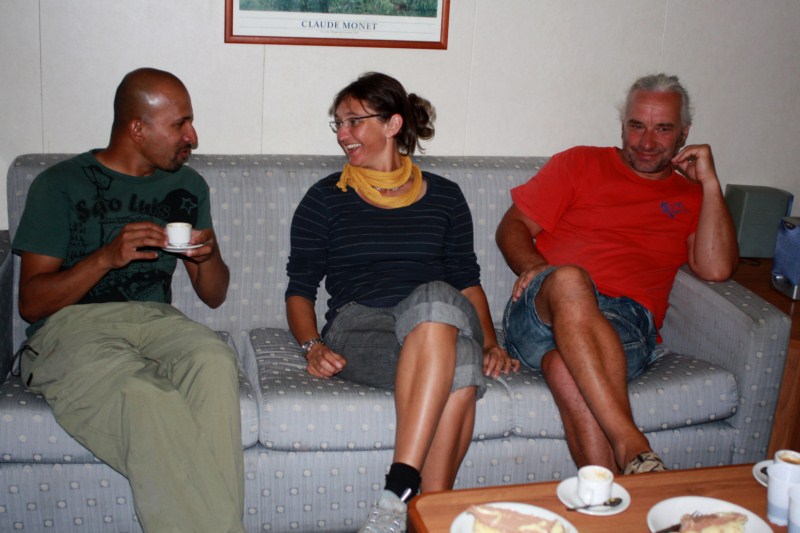
By now, 18 days into the trip, we were well-settled in our routines on board, which was dictated by meal times. Enjoying a conversation with Sandra over some after-meal espresso.

Some of the fish that was caught in Dakar was salted and sun-dried on the top deck.
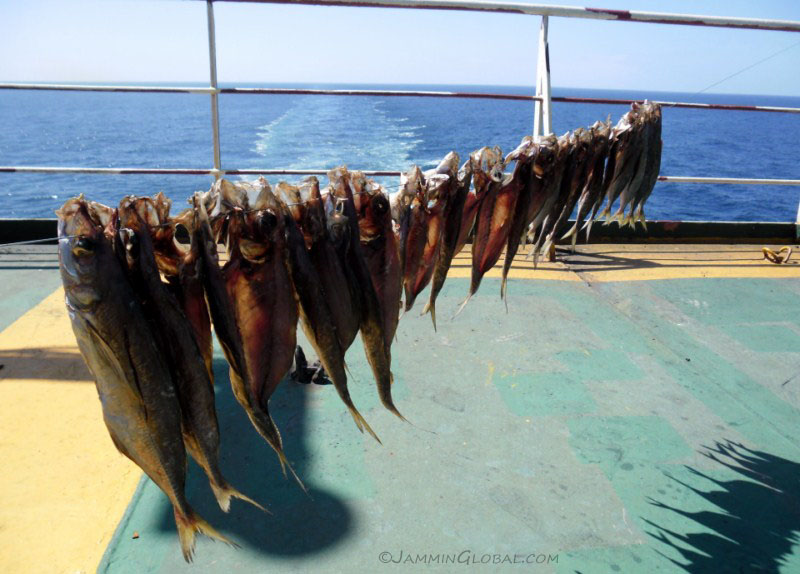
Mmm, this would make a good snack.
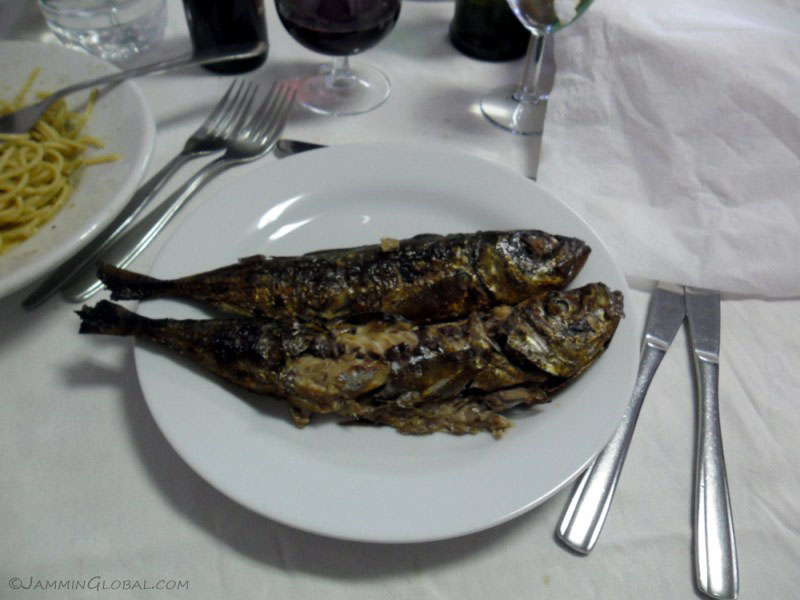
And then, we finally had the fish barbeque, which was delicious.
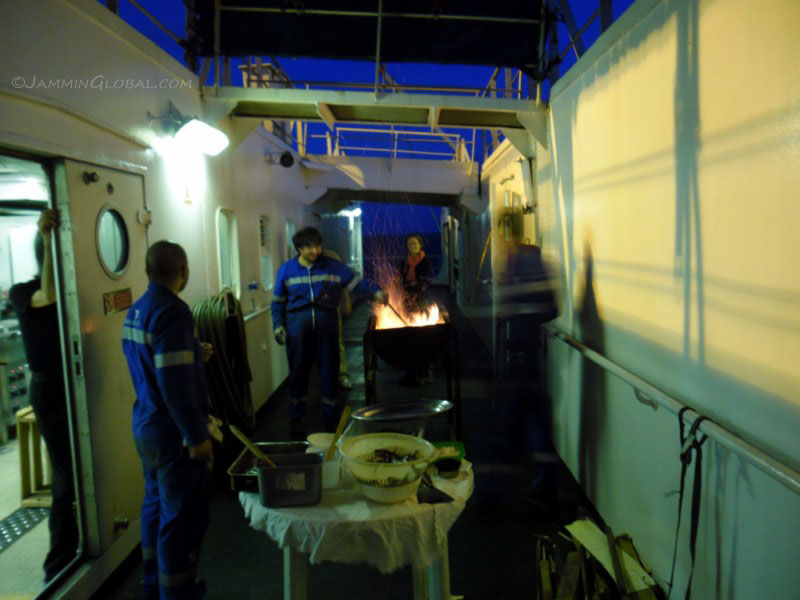
The officers were out back manning the grill.
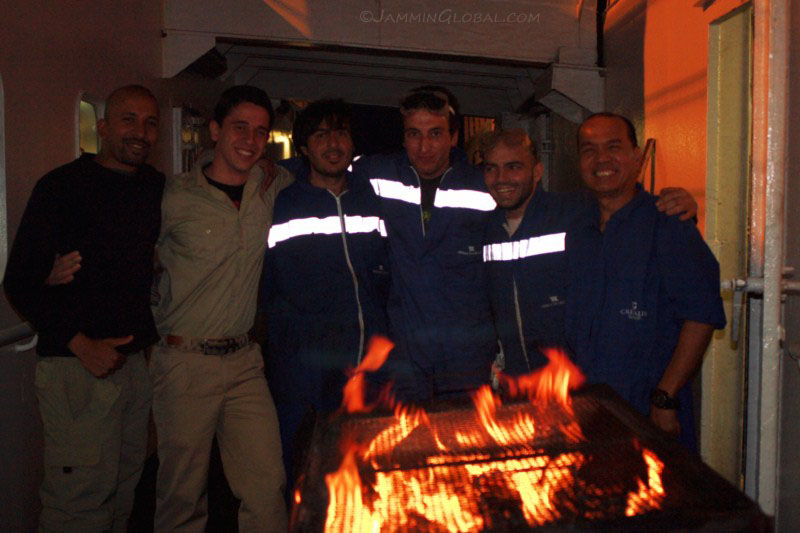
They were a friendly bunch and enjoyed sharing this moment with us.
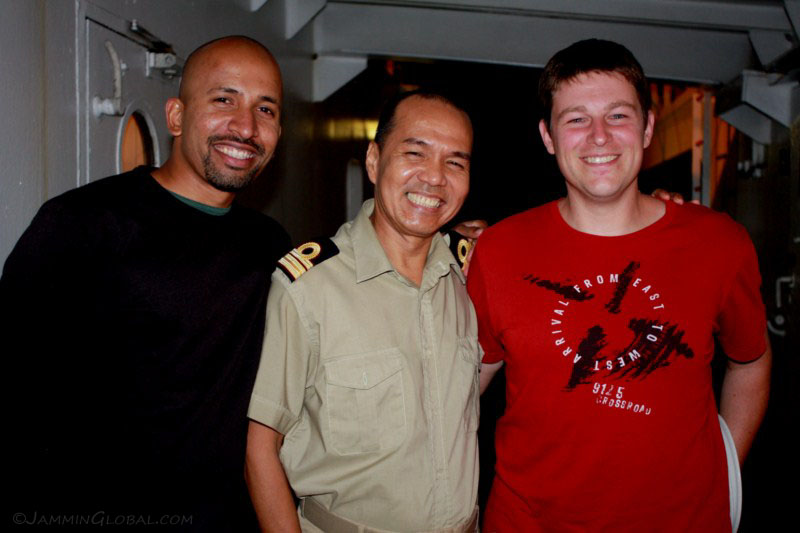
With Chief Engineer Hufalar from The Philippines. When I told him I was from Madras, he said he was in port there on a ship in December 2004, when the Sumatra Earthquake and Tsunami struck and his ship was lifted 10 m (33 ft) and dropped back down, but many other ships sustained a lot of damage there. We asked him some questions about the engine and he said the ship carries 3,000 metric tonnes (3,000,000 liters or 792,000 gallons) of heavy fuel oil for the round trip two month journey from Europe and back of 24,000 kms (14,906 mi), which translates 12,500 liters/100km (0.008 kpL, 0.019 mpg). This is a very crude fuel and is highly polluting, but since it's been difficult to pass pollution laws for ships due to their trans-boundary nature, they go on burning this fuel. However, Europe has enacted very strict laws regarding pollution, so the ship also carries 400 mt of light fuel oil for burning when they enter European ports. There's also 100 mt of gas oil on board, which is slightly heavier than diesel, for all the heavy machinery that is used in moving the containers around. The Chief Engineer was also delaying on giving us a tour of the engine room, so we pushed him on that.
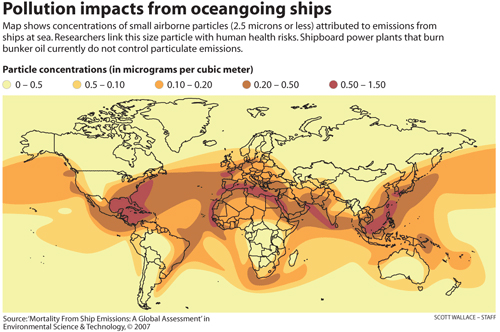
A world map highlighting the regions that have increased air pollution due to ships. The heavy fuel oil (bunker oil) is not controlled by any regulation for its particulate emissions and us passengers felt a bit guilty seeing the thick black smoke bellowing out of the ship's chimney stack as we used its dirty services. It would be simple to throw a filter on their to reduce the amount of particulates being ejected out, but this would reduce performance slightly and no one has been able to pass such global regulation. However, each region can set its own rules, as Europe has done, and with climate change mitigation becoming a reality across many industries, it's only a matter of time before cargo ships have to shape up and do their part to reduce their carbon footprint.
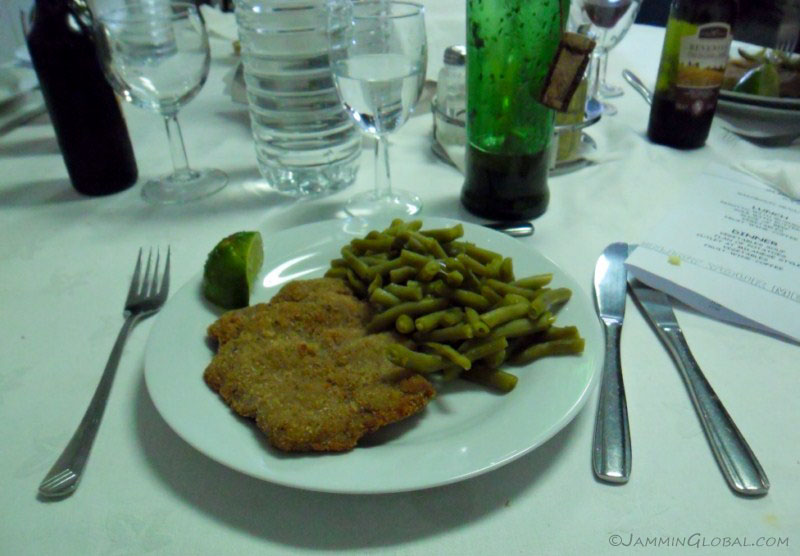
For some reason, I didn't take too many shots of the food, but it was mostly very good. This is some breaded steak (like a milanesa) with green beans. After pigging out the first two weeks, we all slowly started refusing the second course of meat. We knew we had to get accustomed to normal eating quantities as we would be getting back on land soon and feeding ourselves. An interesting point about meal times was that we had to sit in the same seat for every meal. In the first few meals, we all shuffled around to get to know everyone, but Franchesco didn't like this since he wanted to pre-place our drink orders and forbade us from moving around. The ship certainly likes its order.
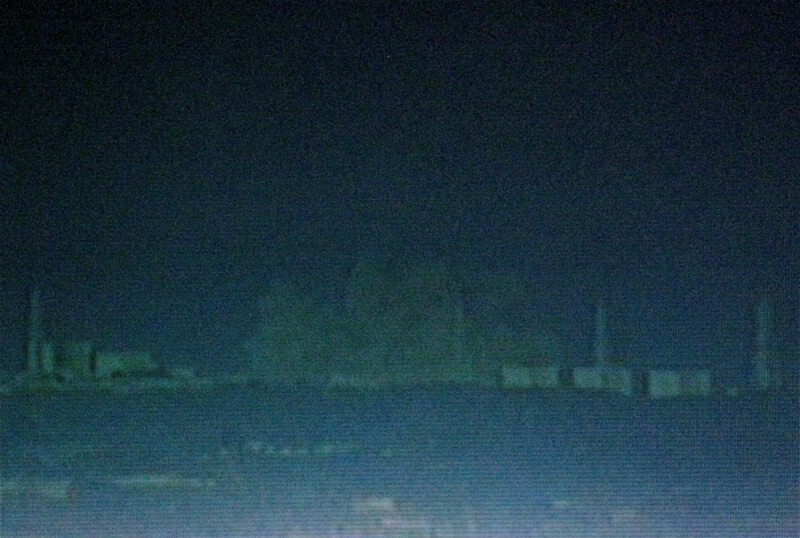
There were TVs in our room that were meant for capturing over-the-air channels when we got into European waters and after we got near France, we could get BBC World News. I was fine without internet access for so long on board, but was starving for world news. The first day was just the usual news reports, but the next morning, March 11, brought news of the Tohoku Earthquake and Tsunami in Japan. I was glued to the TV from then on as this incident was slowing playing out in real time. When people in Tokyo complained of experiencing motion sickness due to the 6 minute long quake, we could relate, as the ship was swaying quite a lot in the stormy waters off France. It was also a strange feeling to be out on the high seas, albeit on the other side of the planet, in a different ocean, as the tsunami was rapidly spreading across the Pacific. It took about 22 hours to reach Chile. Klaus managed to capture the moment when the Fukushima 1 reactor exploded due to a build up of hydrogen inside the damaged nuclear reactor. The Japanese people are resilient and I wish them strength as they climb out of this massive disaster.
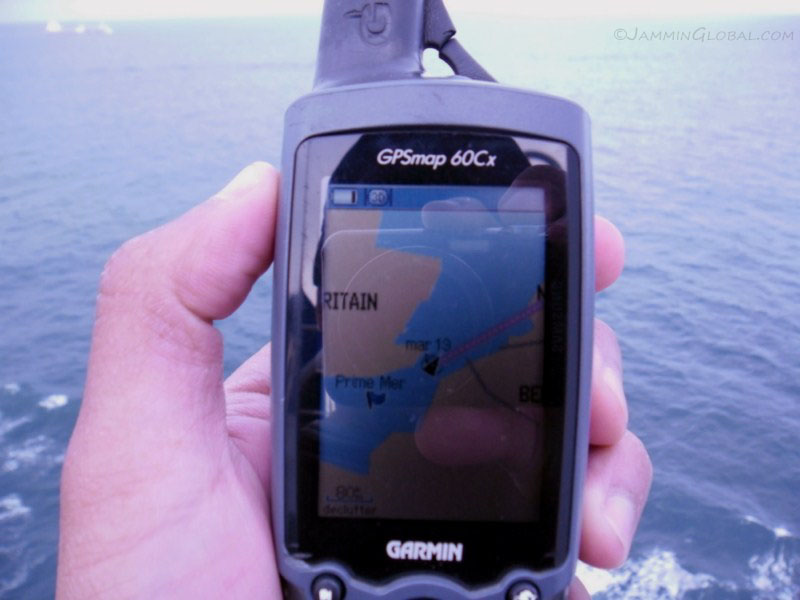
As 'Fukushima' was becoming a common household name, the Grande Francia passed through the English Channel. We had also crossed the Prime Meridian the day before and were now officially in the Eastern Hemisphere of the planet.
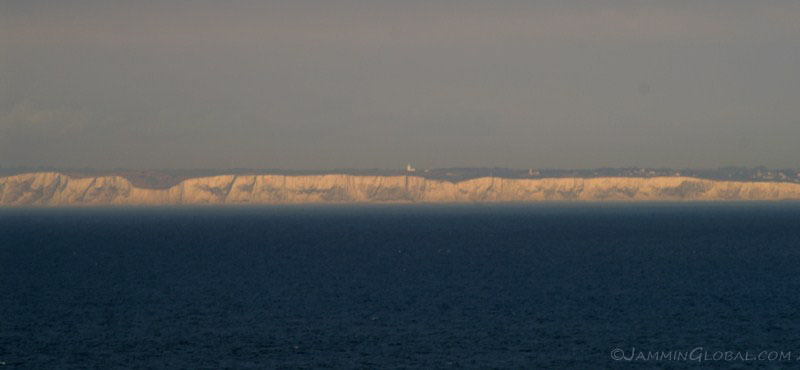
The White Cliffs of Dover across the channel on England's southeastern coast. The South Foreland lighthouse can be seen on top of the 100 m (330 ft) high cliffs of chalk, which are the compacted skeletal remains of millions of single-celled planktonic algae. The cliffs have stood as a symbolic guard to England through the ages of attack from continental Europe.
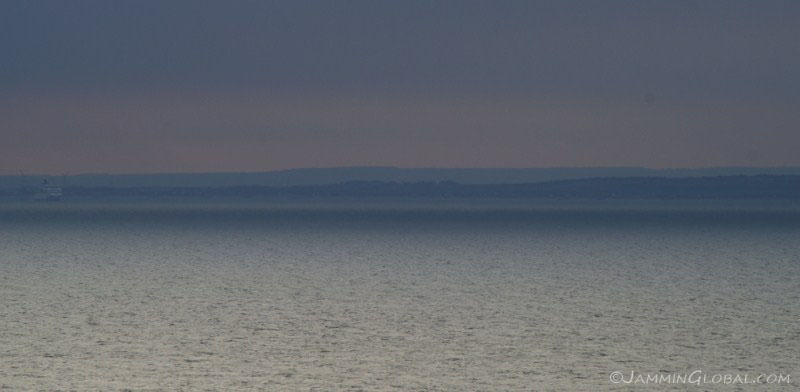
Looking the other way at Cap Gris Nez, near Calais in France. The English Channel is at its narrowest between Dover and Calais, with only 34 kms (21 mi) of water separating the British Isles from Continental Europe.
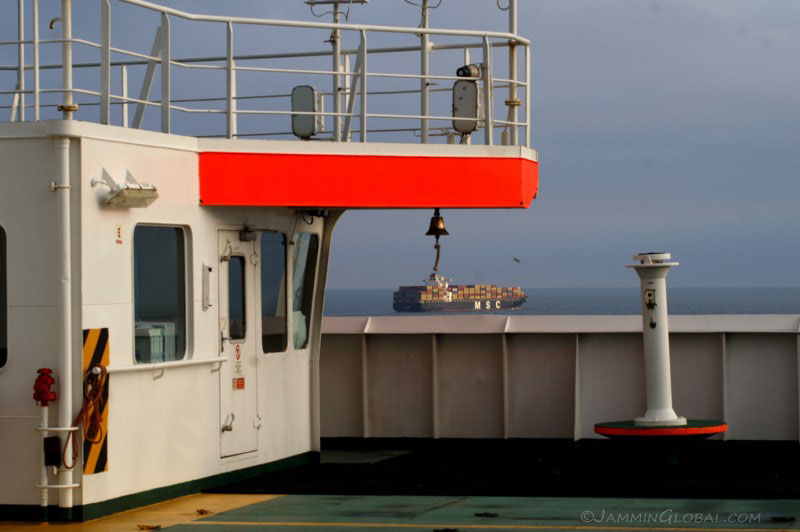
The channel connects the North Sea to the Atlantic and is a very busy shipping lane, as is evident by the close proximity to this MSC container ship.
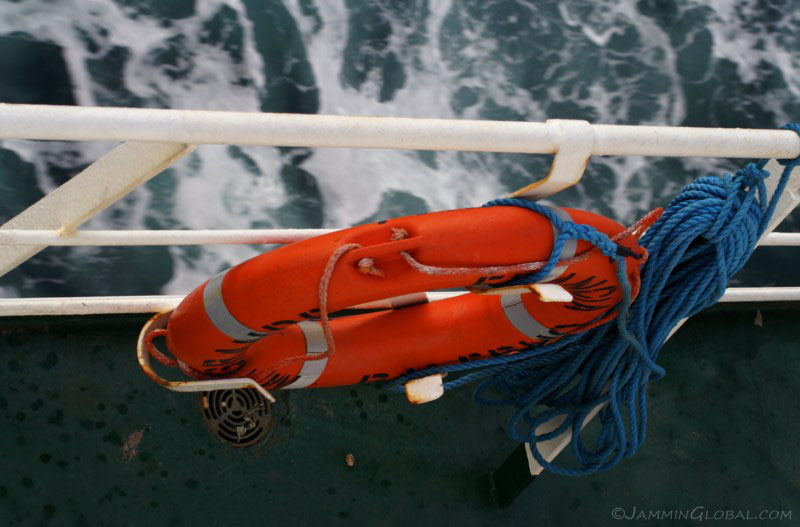
During the entire trip, it was reassuring to see how safety-minded the crew was.
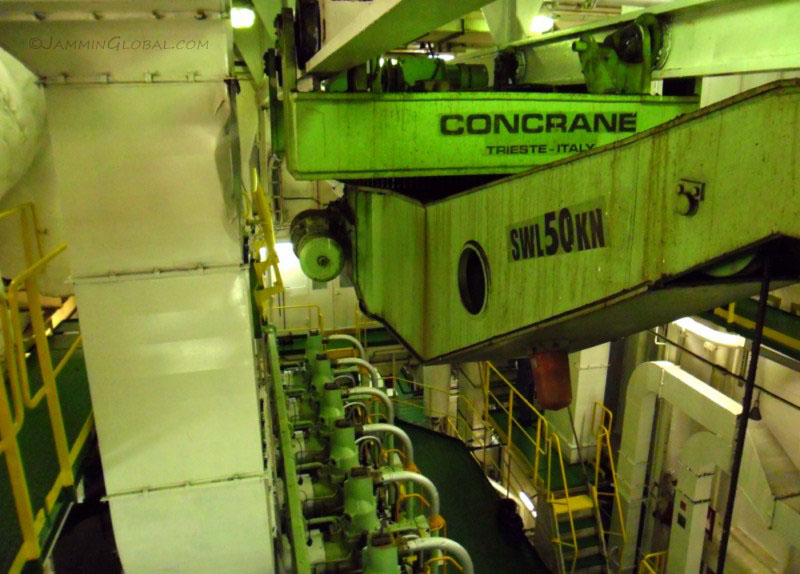
And finally, we got our tour of the engine room.
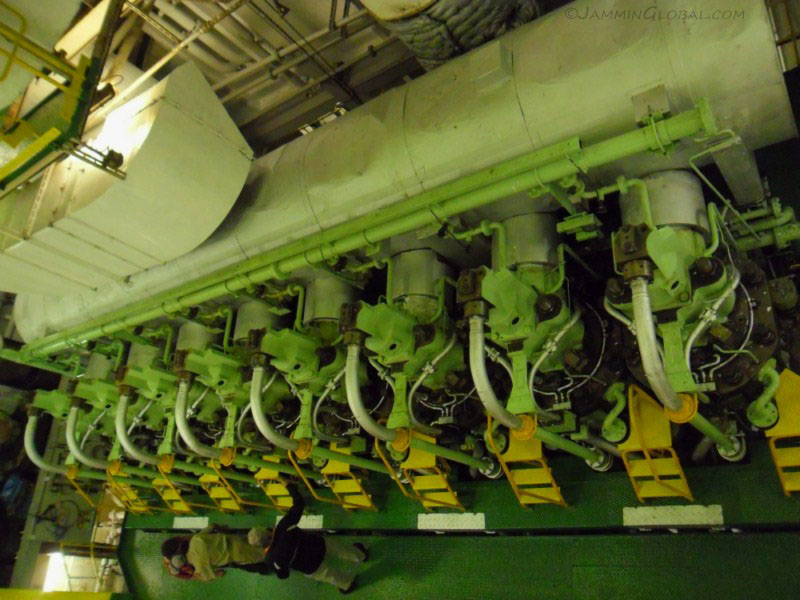
Looking down at the top of the eight in-line cylinders of the diesel engine that's...
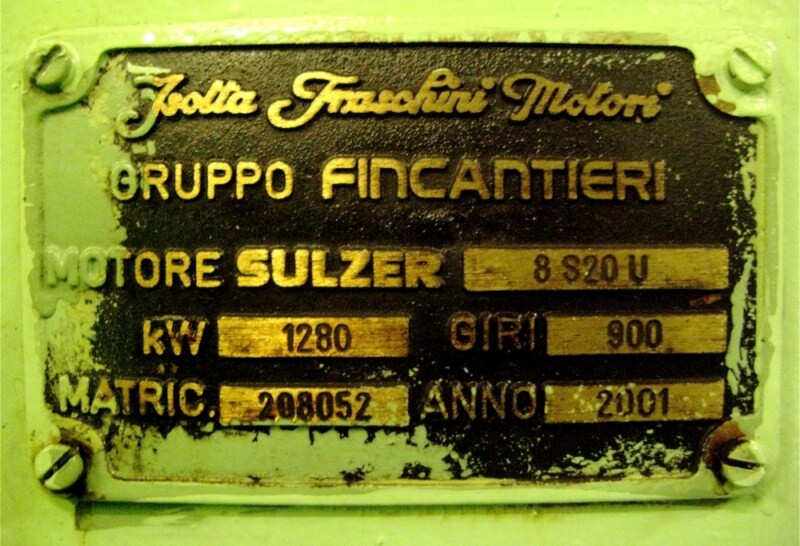
...made by Sulzer, a Swizz company. The model number is 8 S20 U and it's maximum power is 1,280 kilowatts (1,715 horsepower) at 900 RPMs. It was made in 2001. It doesn't seem like that much power for moving such a huge ship, but it gets the job done. Sulzer have been in business since 1834 and a certain Rudolf Diesel worked for them, leading to their first diesel engine in 1898.
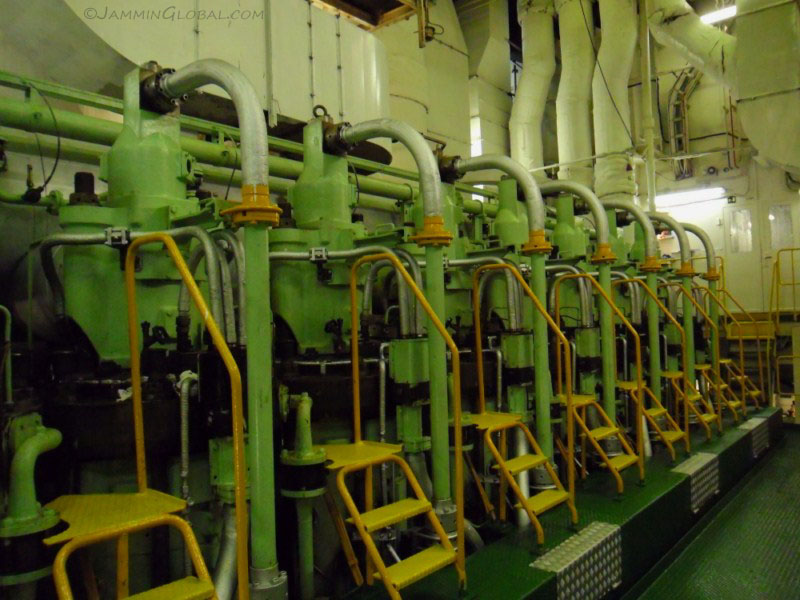
The sounds emanating from this mechanical symphony were astounding. However, I must say I was expecting the cylinders to be much larger. Ok, each cylinder could fit a man in there, but I had this image (I think from the Titanic movie) of room-sized pistons moving up and down, which was ill-placed.
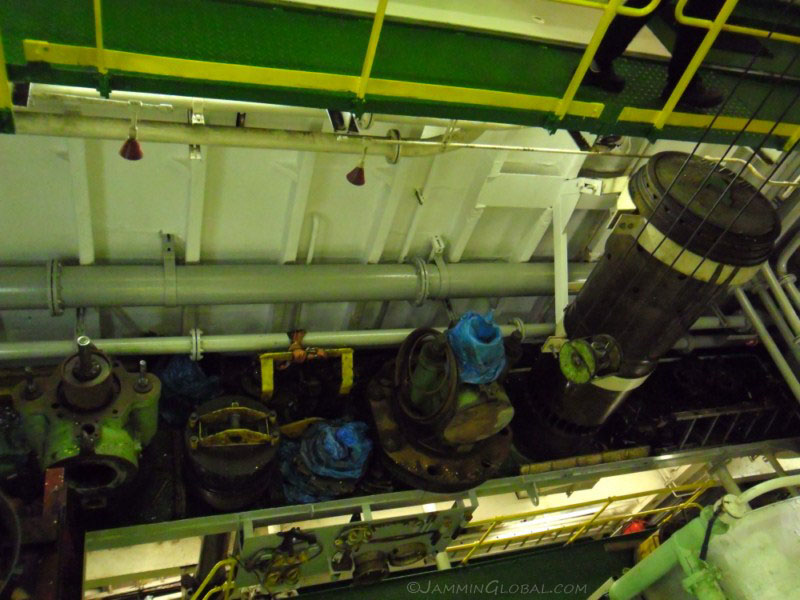
Some spare parts (left to right): piston, cylinder head and cylinder liner. Looks like the stroke (the distance the piston moves up and down) is much larger than the bore (the diameter of the piston) and this ratio would produce much higher torque than horsepower, which is what a diesel engine on a ship would need to do. To distinguish between torque and horsepower, to me, torque is more relevant at low speeds to get things moving and horsepower is more relevant at high speeds to keep things moving.
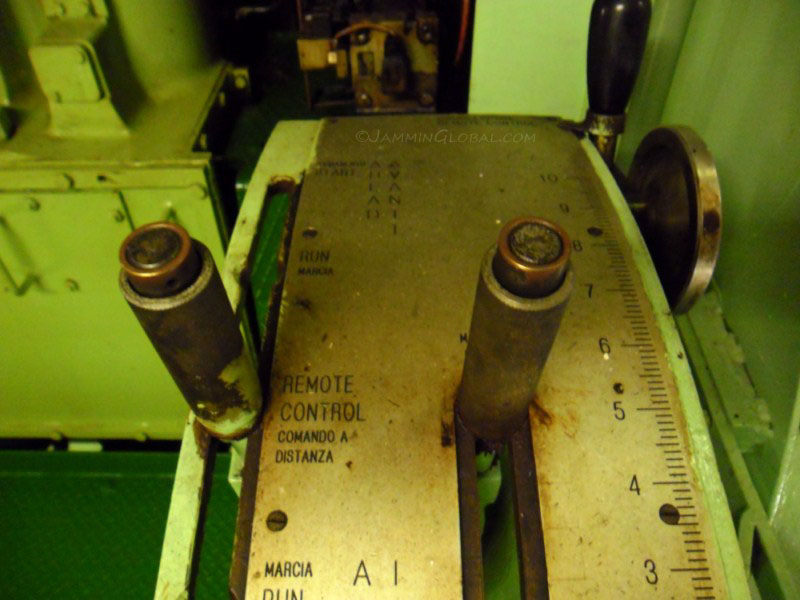
The engine is on remote control (comando a distanza), meaning the engine is being controlled from the bridge. Wonderful to see such huge, manual levers.
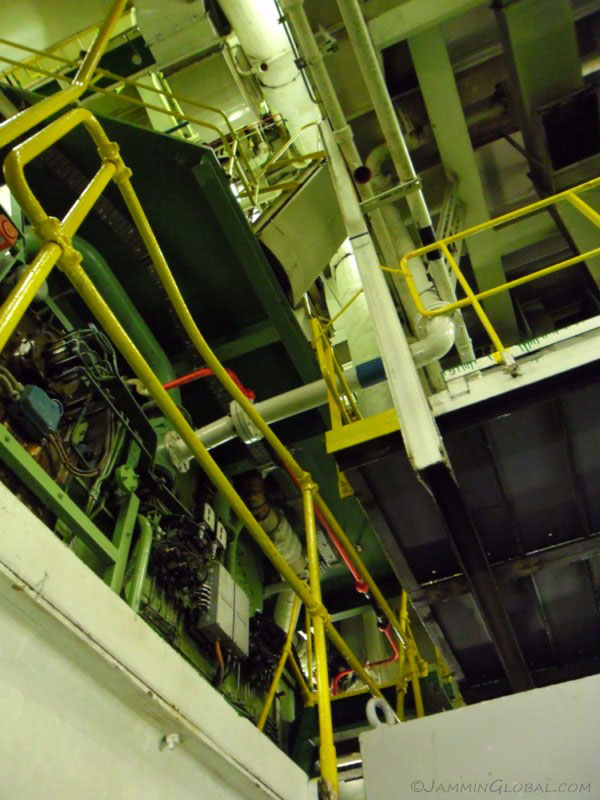
More than an engine room, this is a cathedral for mechanically-oriented people. The engine spanned three floors.
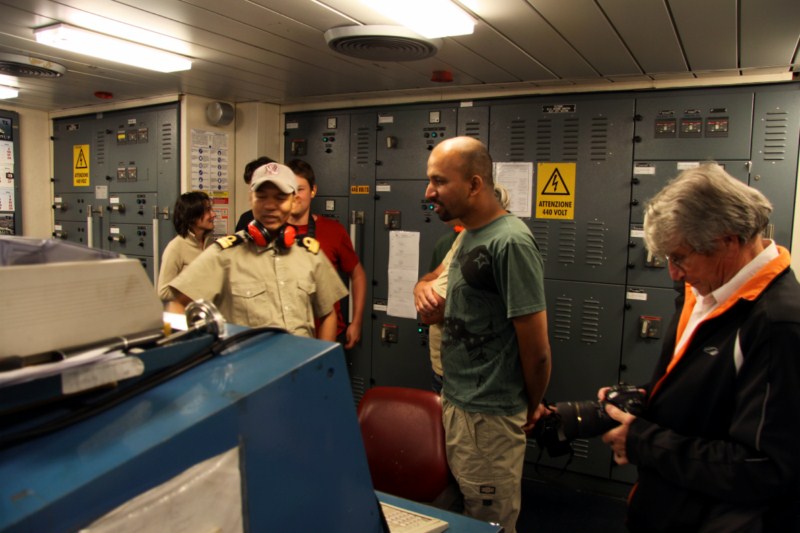
Chief Engineer Hufalar giving us the tour of his control room. I tried to find out some more details on the engine, but could not get from him the capacity of each cylinder. Regardless, he was very eager to show how all the controls worked and even started and shut down a generator from his touch screen just to show us.
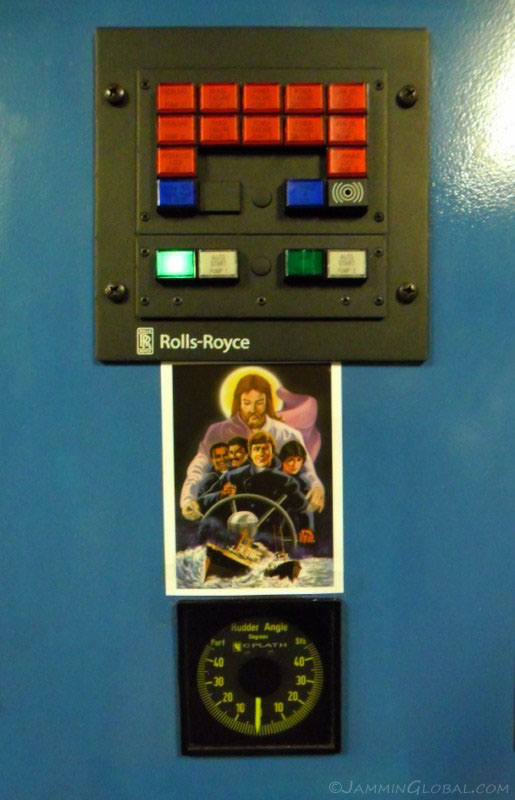
Filipinos are known to be highly religious and besides the good people at Rolls-Royce Power Systems, El Cristo is also looking over them.
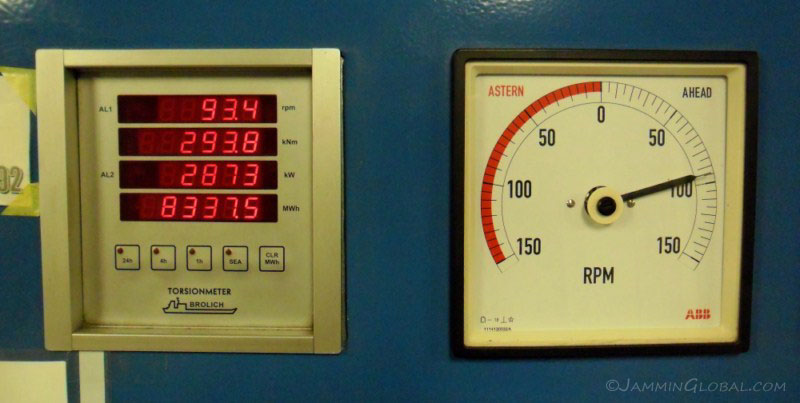
While the engine spins in the hundreds of RPMs, the output/propeller shaft is geared down to spin in the tens of RPMs. During the Brazil-Dakar leg, we were on time and had enough days to cruise at the slower speed of 13.5 knots (25 kph, 15.5 mph) to save fuel and the output shaft was spinning at 89 RPM. After the two day delay in Dakar, the ship had to step it up to still make it on time to Europe and the propeller shaft increased ever so slightly to be now spinning at 93.4 RPM. That translated to 17 knots (31.5 kph, 19.5 mph) and now we could feel the engine vibrations throughout the ship. On the Atlantic crossing, it was smooth as glass. It was amazing how such small differences in speed are highly relevant when the size of the object and the distances covered are enormous. When cruising at 25 kph, we were covering 600 kms (373 mi) per day and now at 31.5 kph, we were covering 750 kms (466) per day, since the engine is running 24 hours a day. The second readout on the display is the amount of torque being applied through the shaft of 293.8 kilonewton metres (216,296 foot pounds). Now, that's what I'm talking about! For comparison, your average car puts out around 150 ft-lbs. This makes logical sense, because to move such a huge object, it's all about the torque. The third readout is the amount of power being produced by the engine of 2,873 kilowatts (3,851 hp), which I don't fully understand as it's more than double the amount stated on the engine plate, but perhaps the engine has been upgraded. The last readout is of energy, which is power produced over time (or work done) of 8,337.5 megawatt-hours
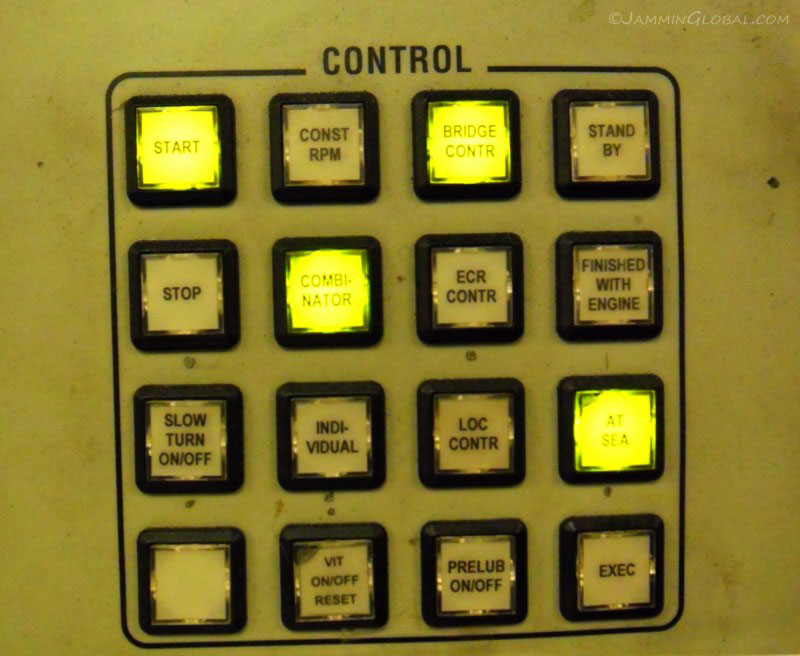
Control board showing that the engine was being controlled by commands from the bridge, instead of directly from the engine room's controls.
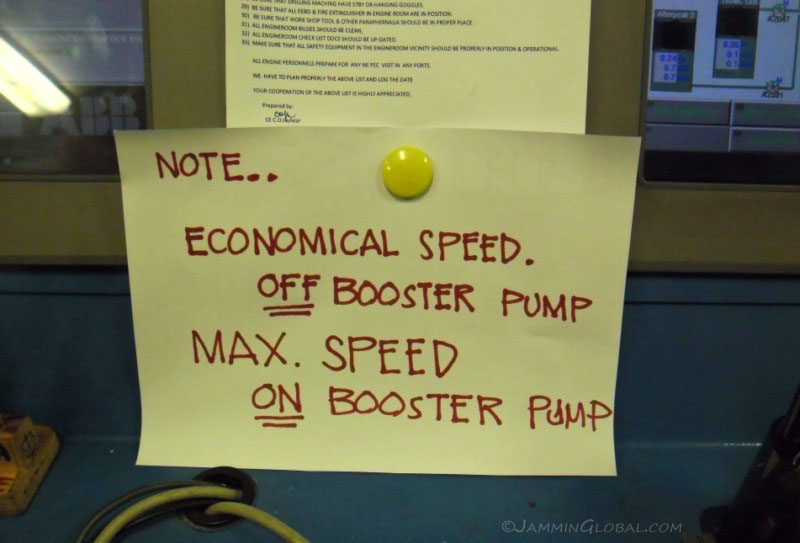
A reminder on when to use the booster pump; must be like a turbocharger. It probably kicks in when we cross 90 RPM.
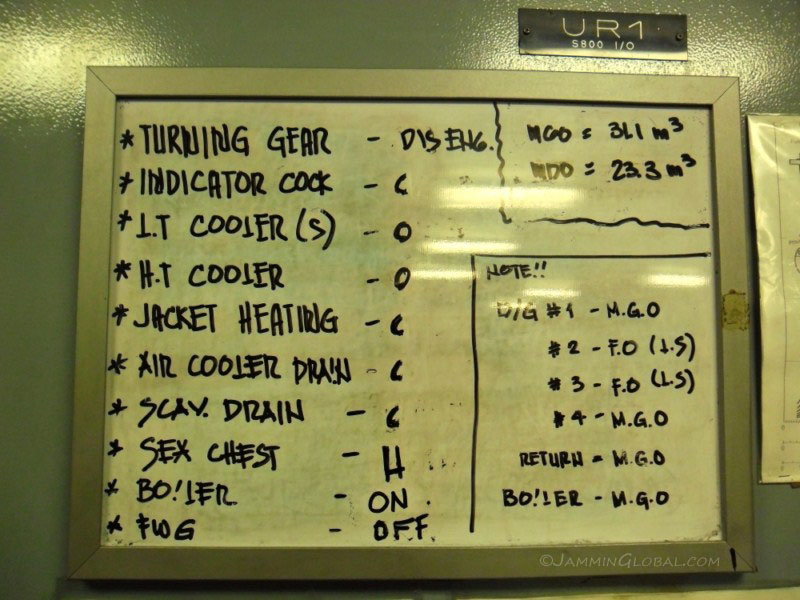
I wonder what the third item from the bottom refers too... (joking aside, it reads Sea Chest)
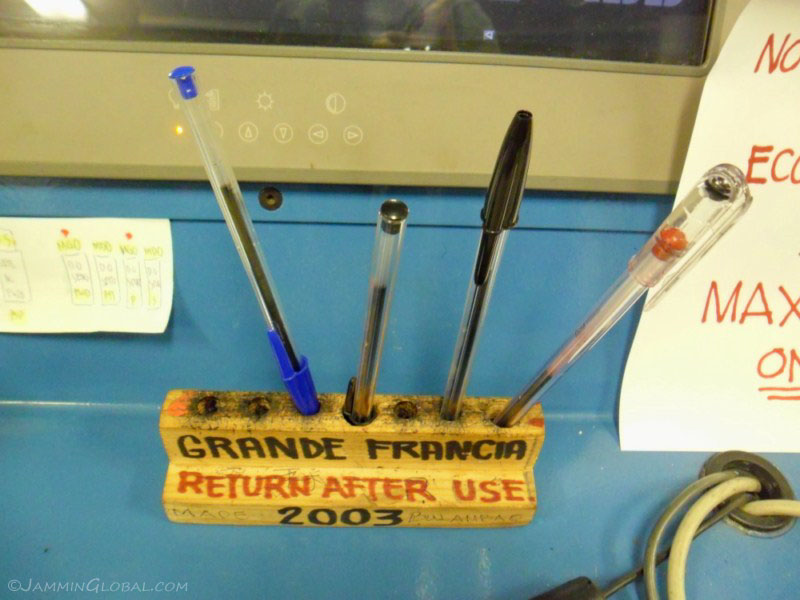
This is after all just another office desk, albeit one that controls a massive engine plowing through the oceans.
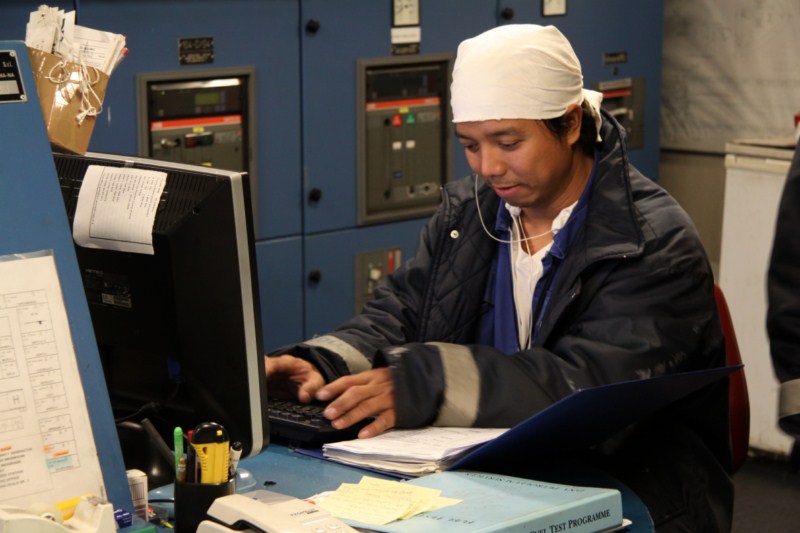
Andres, sitting at one end of the control desk, was in charge of all the electronic components related to the engine. He was a cadet, in training to become Chief Engineer.
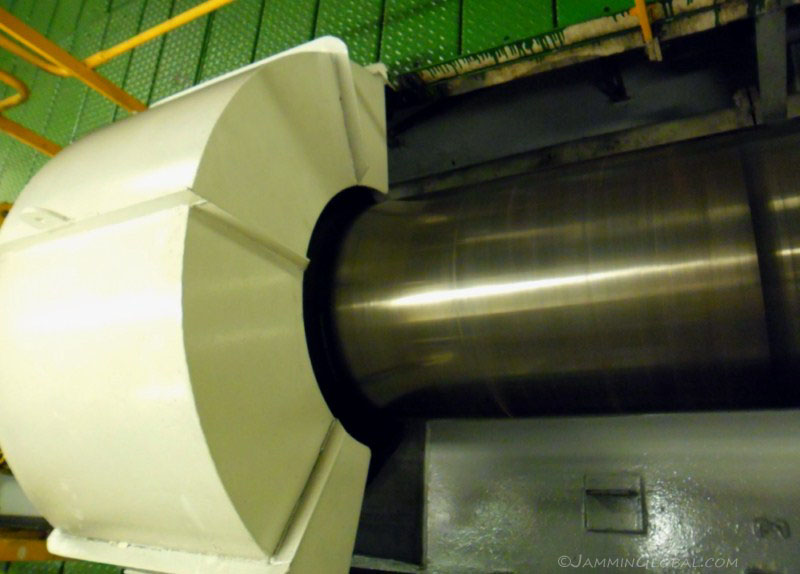
The massive propeller shaft coming out from the engine and spinning at a stately speed with copious amounts of torque.
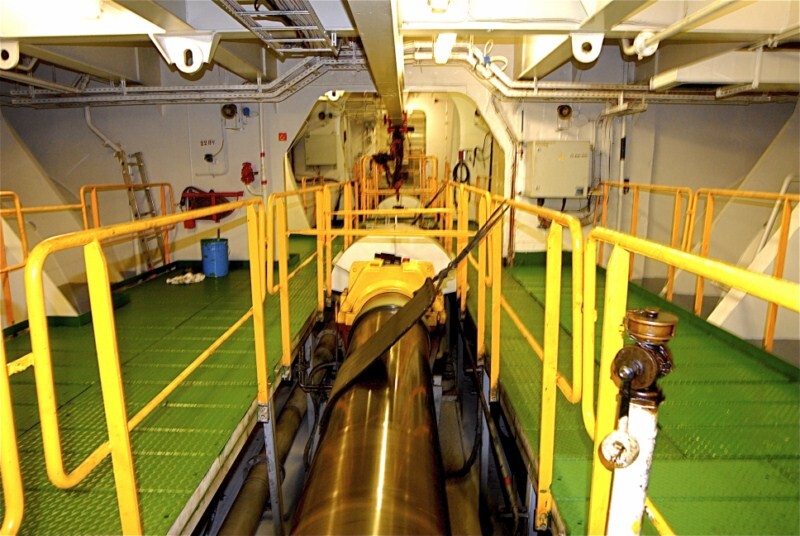
The shaft going out the back of the ship and working round-the-clock to propel us ever forward.
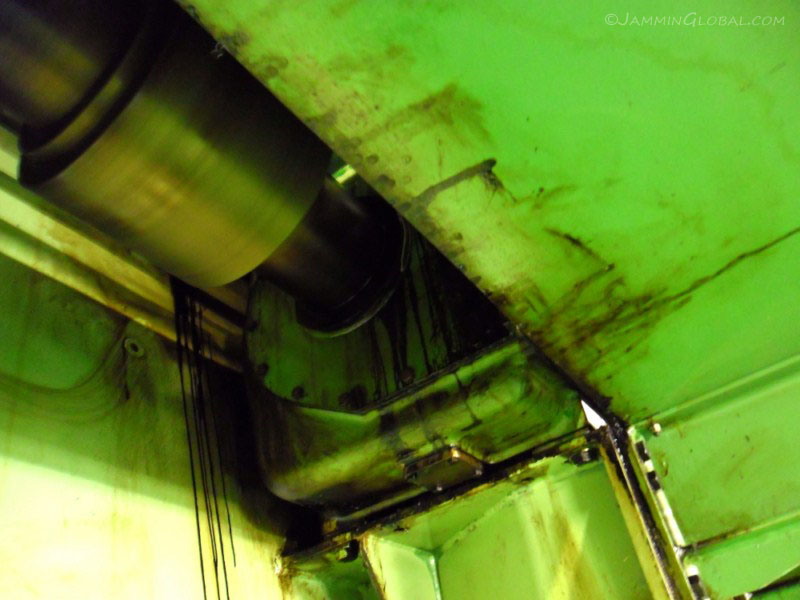
The Chief Engineer was delaying our engine room tour because he was still cleaning up some oil spills. A few days earlier, the ship came to a stop out in the open water for a few hours and later we found out that the increased vibrations from the higher speed after Dakar had cracked a bolt that held an oil filter in place and oil was spewing out. They fixed the issue, but had a big cleanup task. After that, there were two more engine stops and I was impressed that we still made it on time with those issues.
_
Another piece of information that I couldn't glean from the Chief Engineer was how long was it between oil changes. It's obviously a very large quantity of oil that lubricates the internal parts of the engine and it sounded like the oil was never changed or maybe only at a major servicing. He said oil samples were periodically submitted to a laboratory to inspect the condition of the oil and I couldn't get an answer to what happens when the oil is no longer suitable. I think the lubricating oil is slowly consumed by the engine and it's constantly being replaced.
One fact to appreciate while being on board was that the engine never stopped running (except for those 3 unexpected incidents), as even when it's not providing forward momentum, it has to run the generators to provide electricity and desalinate seawater. Once the ship is in service, it's constantly running back and forth along its route with periodical crew changes. If the ship is ever docked for maintenance, it's losing money and thus, I'm still wondering when the oil is changed in this engine.
_
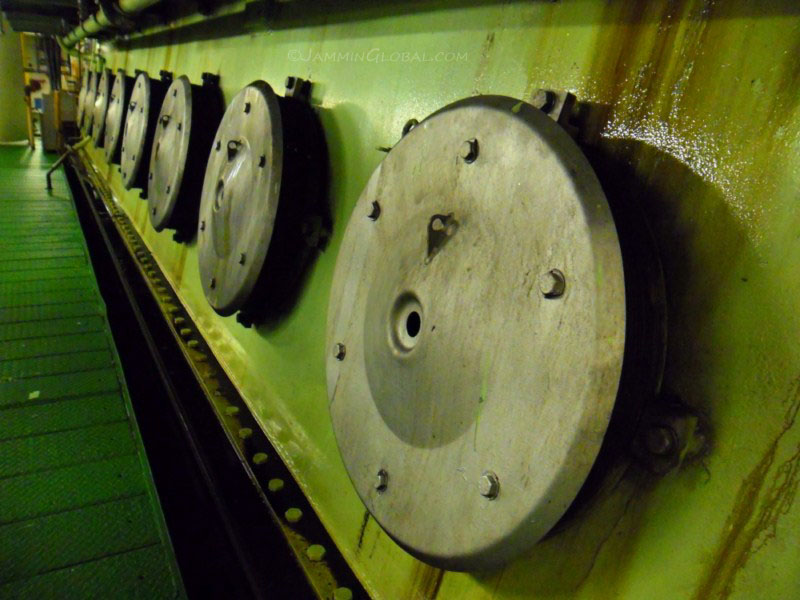
Engine art. Looking at the back side of the cylinder bank.
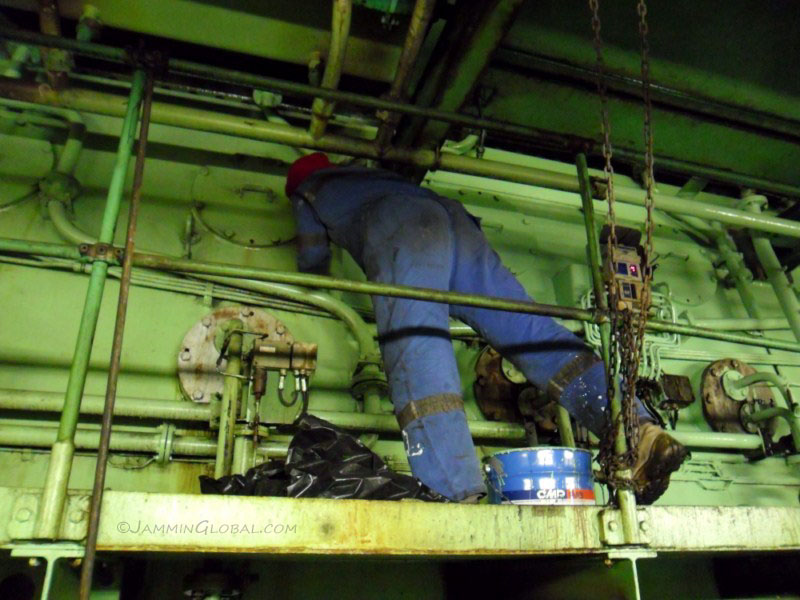
A crew member painting a part of the engine.
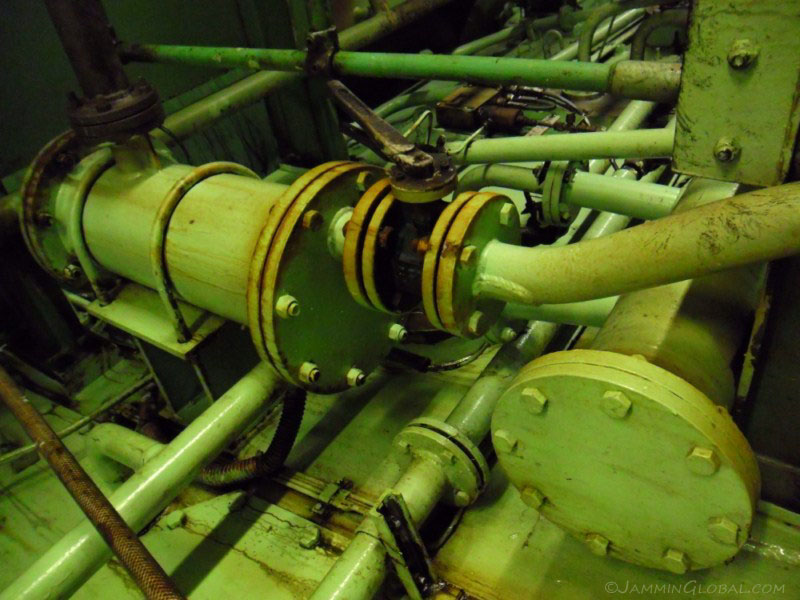
More engine art. Huge plumbing and joints.
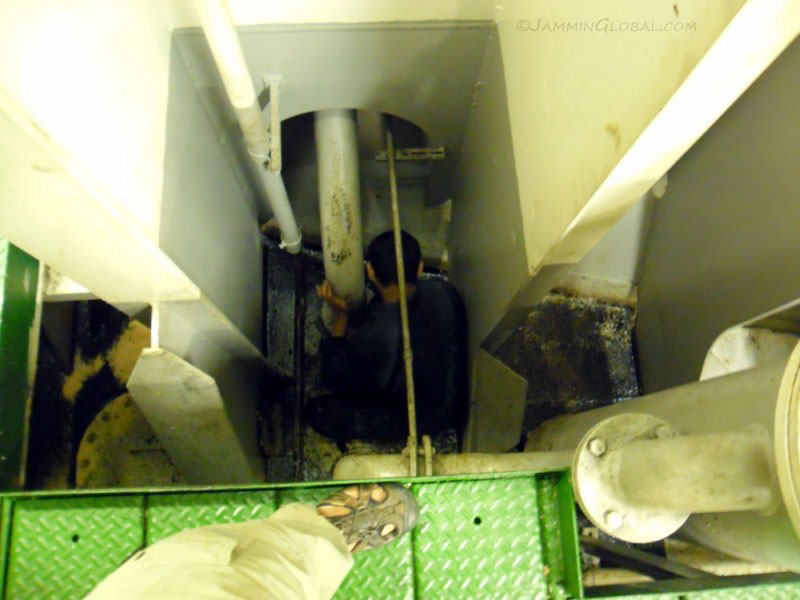
Another crew member down in a nook, painting over some of the ugly parts.
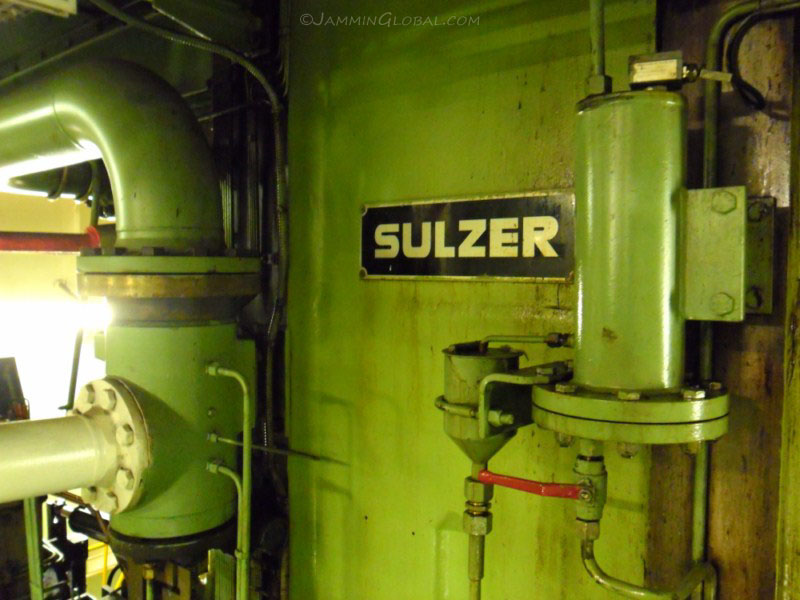
The front of this hard-working Sulzer 8 S20 U.
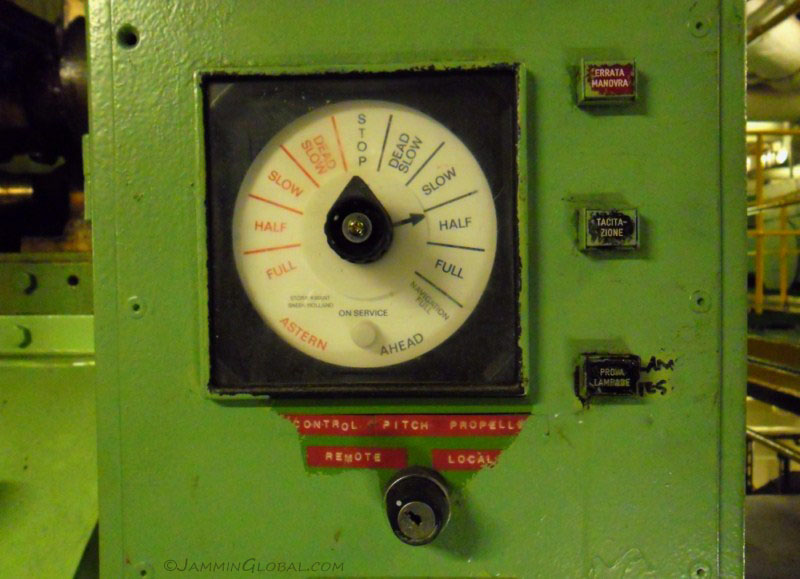
A gauge in the engine room indicating that we were cruising somewhere between 'slow' and 'half' speed. I love how 'dead slow' is a proper speed. With the vibrations we were experiencing at just this speed, I can't imagine what full speed feels like. The engine probably shakes itself loose from the ship.
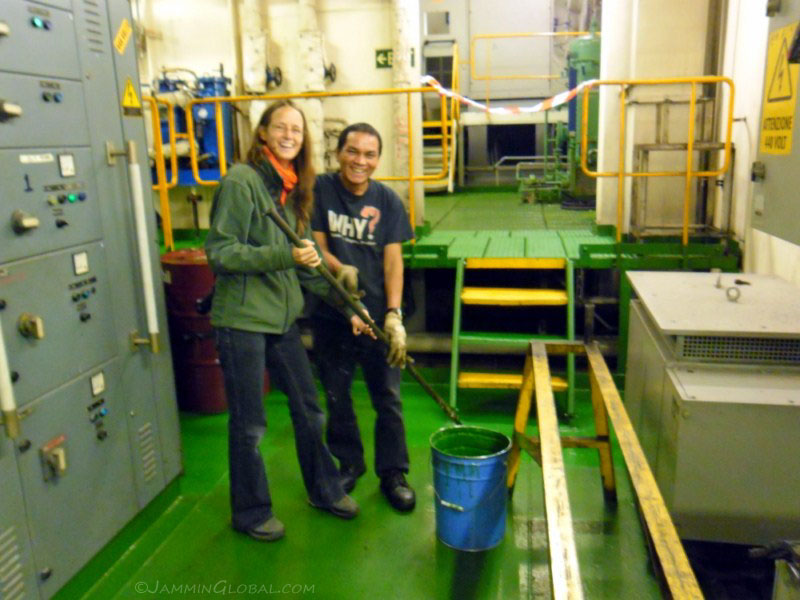
Käthi having a go at covering up some of the recent mess with new paint.
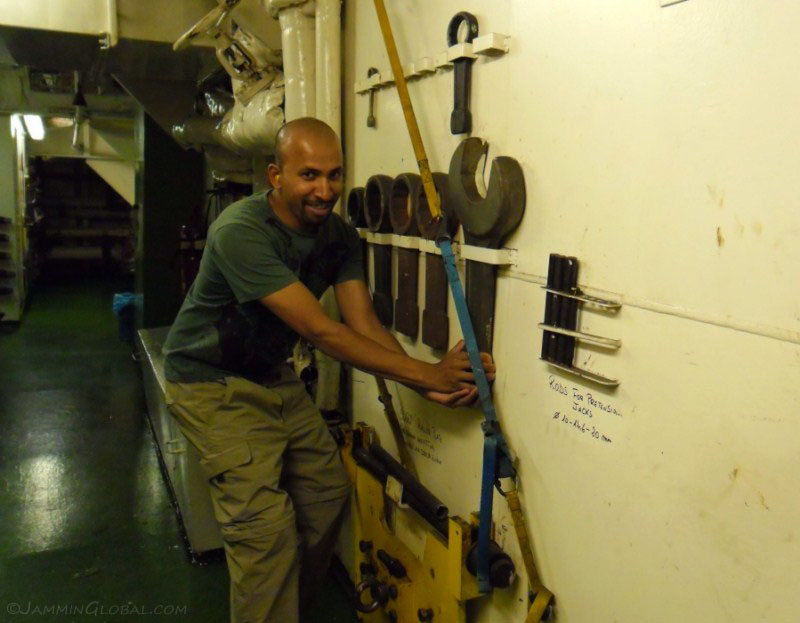
A huge engine has huge nuts and bolts and along with that comes a set of huge wrenches.
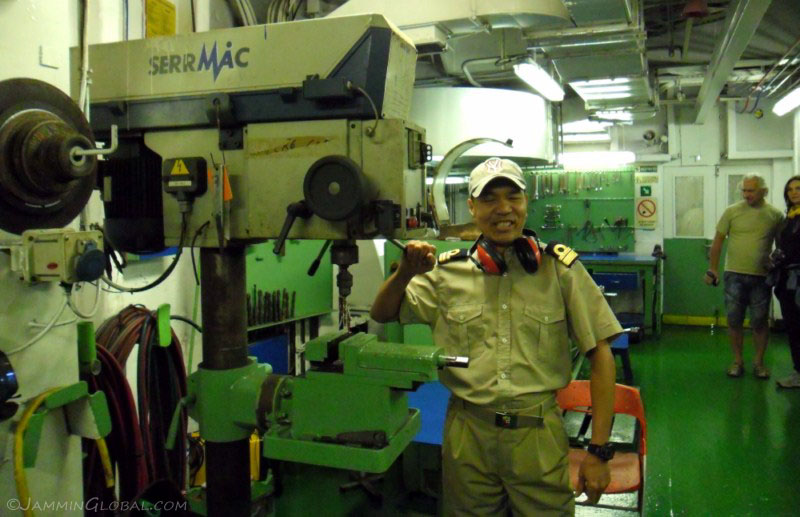
The Chief Engineer in the machine shop, where replacement pieces can be made to specification.
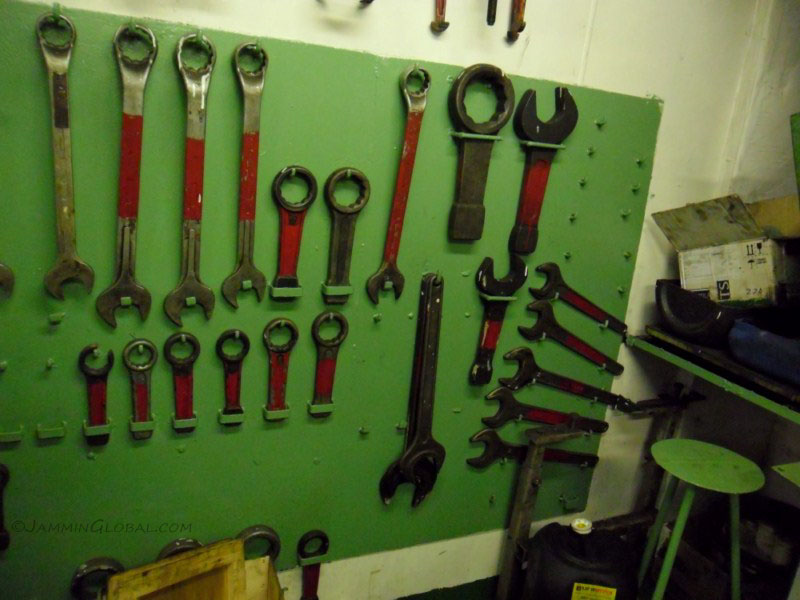
A tool board with mega-sized wrenches.
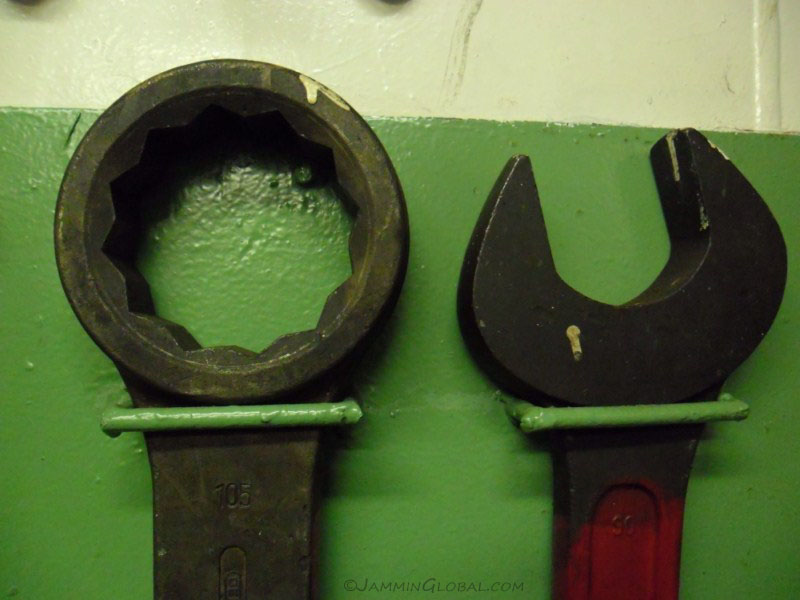
That's a 105 mm and 90 mm wrench. Wow. The biggest I use on my bike is a 24 mm for the rear axle nut. That concluded the engine room tour and we thanked the chief for showing us how the ship locomotes through the oceans.
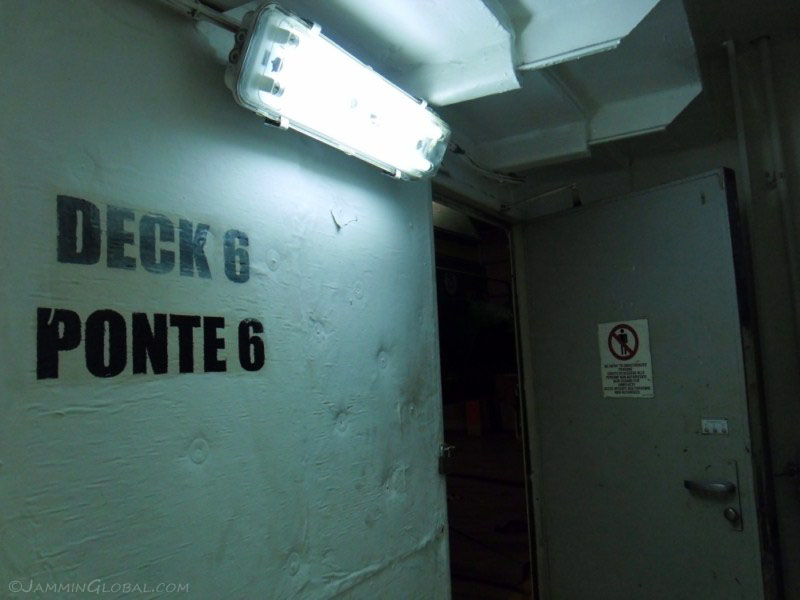
Walking around the ship, I captured a few more shots of my time on board. Deck 6 and the access to where our vehicles were kept.
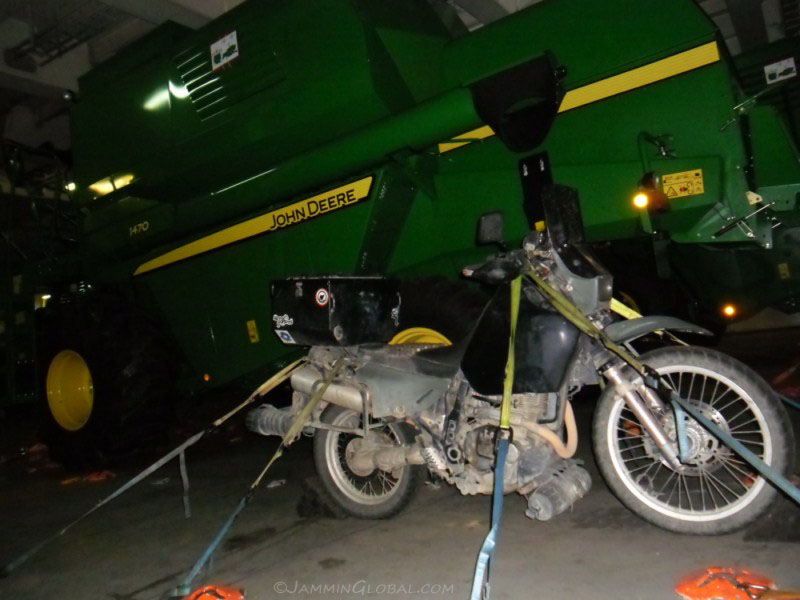
Checking up on sanDRina and her enormous deck mate. This would be the longest time that I've been off the bike on this trip and I was wondering how riding off the ship would feel like after being at sea for close to four weeks.
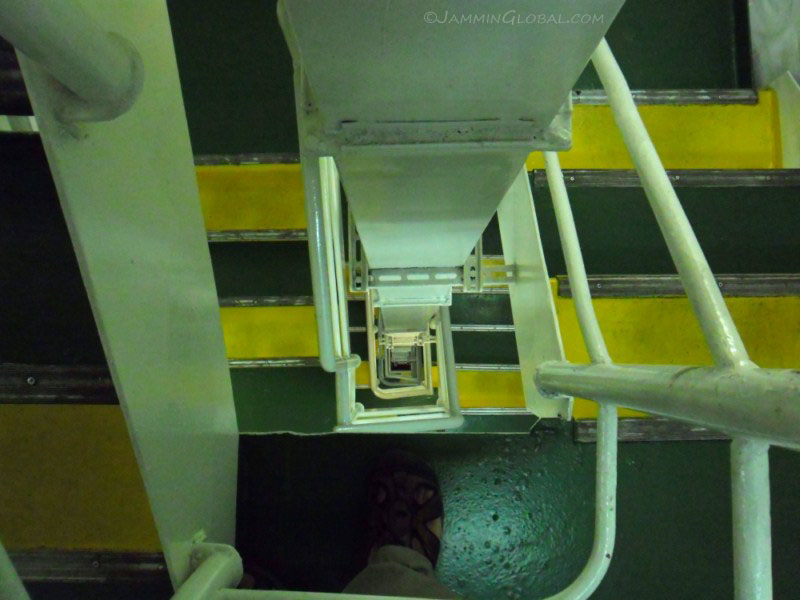
The stairwell, descending down into the depths of the Grande Francia.
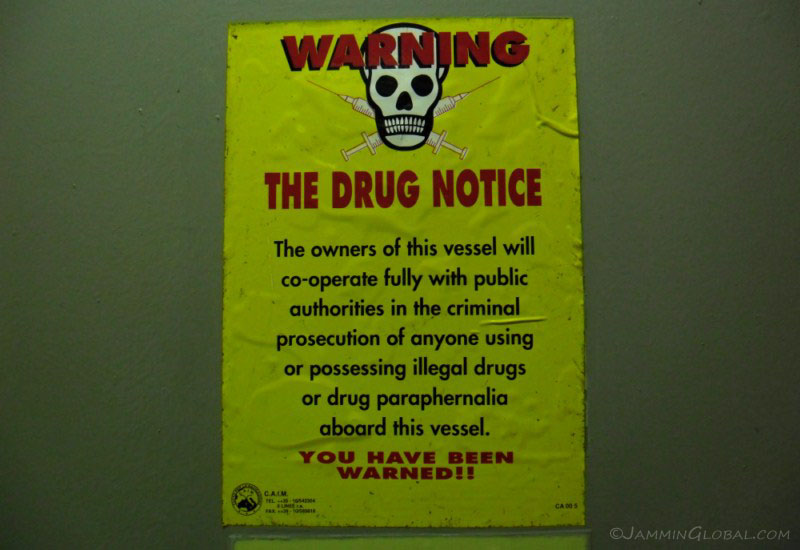
Just so you know. Also, alcohol is banned for the crew members when they're on board, because an emergency situation could arise at any moment and that's why sailors love shore leave; time to booze up.
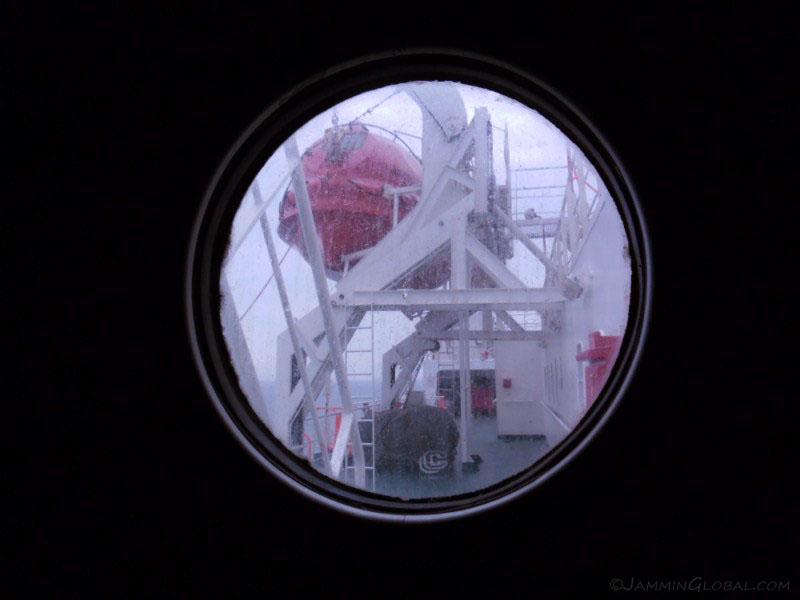
Looking out the porthole of the door I went thru to get outside on deck. They're sealed shut when the weather gets nasty outside, which was mainly cold winds as we went around Europe.
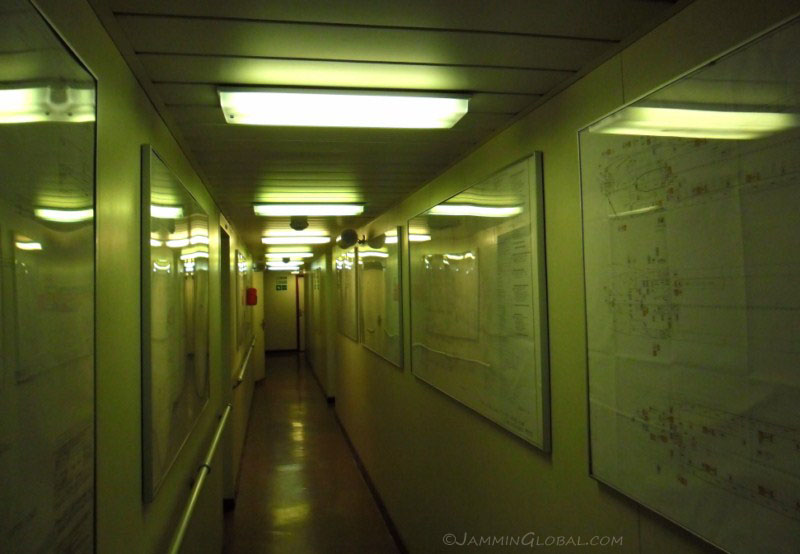
The hallways are lined with all sort of charts with information on the ship. As an engineer, I spent quite a while examining all of them, as it was part of my previous job to produce such prints.
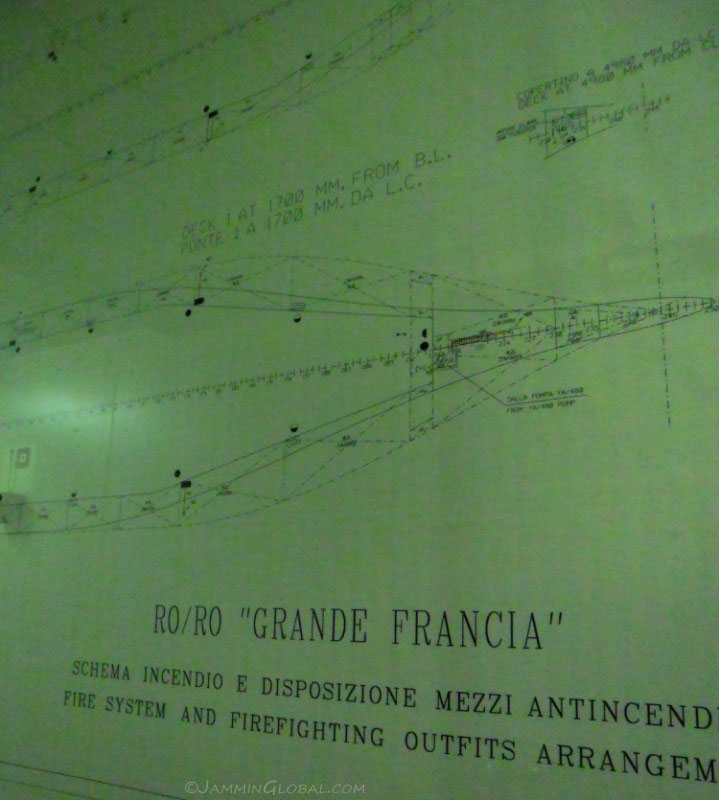
Charts detailed all levels of the ship and it was interesting to see where all the fuel was stored, which was in the bottom-most level and along the sides.
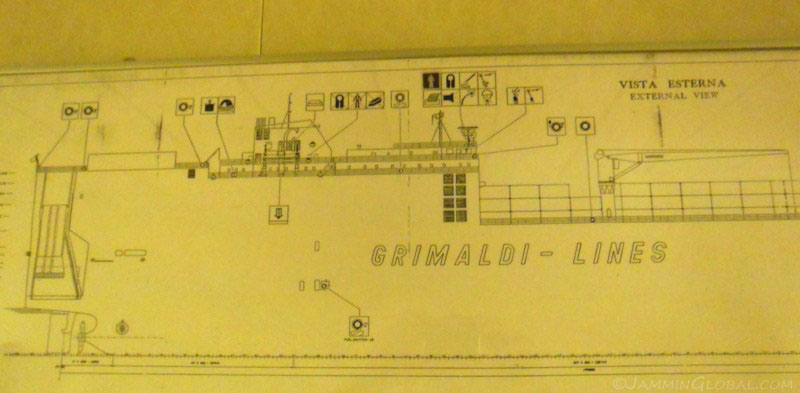
An external view of the ship.
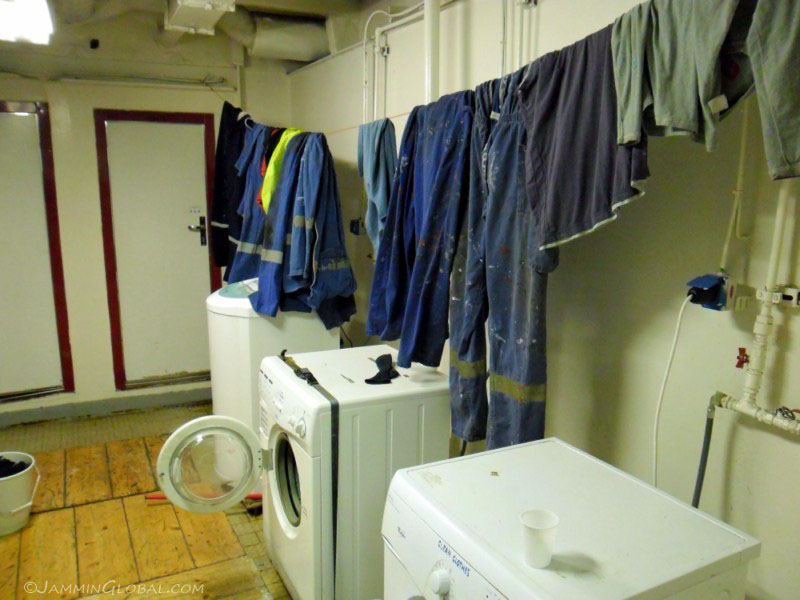
Laundry room for the crewmen. The passengers and officers had their own laundry machine and as we neared the end of the journey, I reorganized all my belongings and washed everything possible.
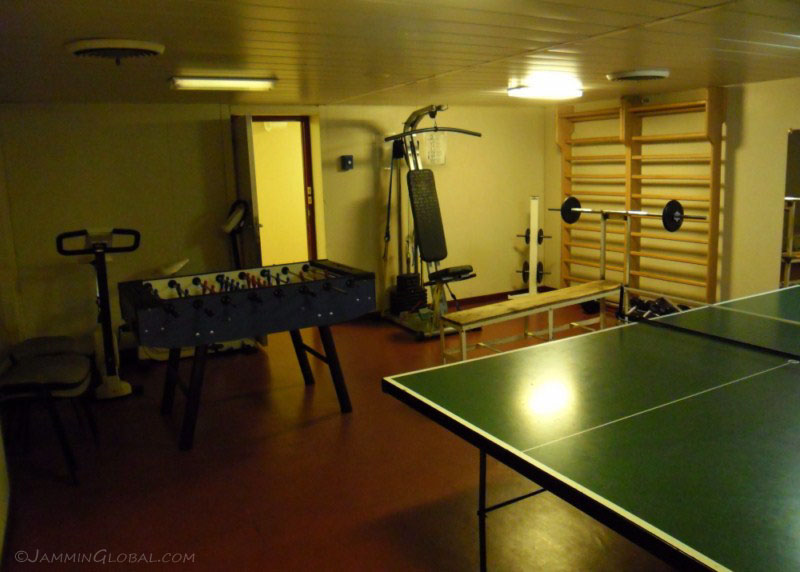
The on board gym, which had some weights, a resistance machine and a cycling workout. There was also foosball and table tennis, which Klaus and I played a game of everyday at 3 pm to break up the afternoon and get the blood flowing.
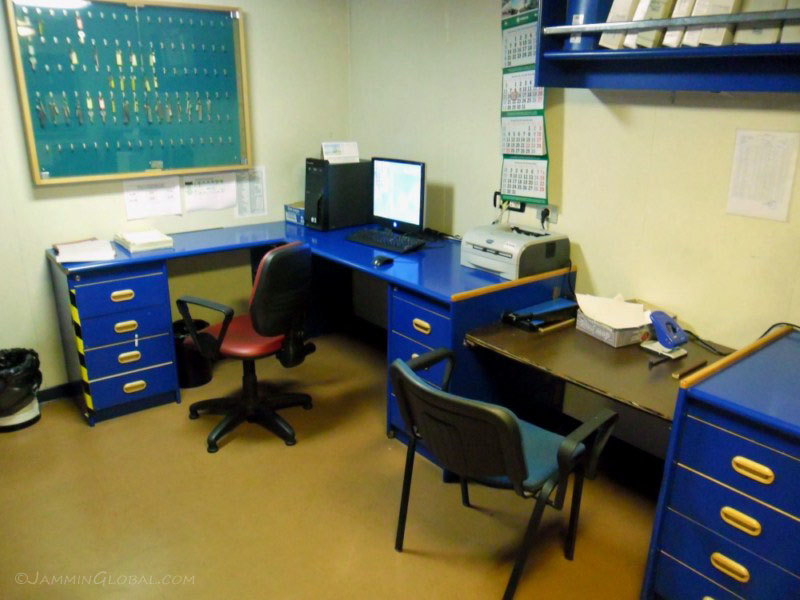
The computer room where we were allowed to send one email a day with a limit of 2 kilobytes. They stressed that we were not allowed to attach any pictures or include the original message in our replies as they are paying a hefty rate per kilobyte of data sent via the satellite linkup. The communication link is mainly to keep the head office in Naples in constant contact with its ships, to inform them of cargo pickup and drop off. It was nice of them to even offer this to us as it was a vital connection to the outside world in this day and age of internet communications. That's the only thing I missed after about two weeks on board. I think I could've gone for a longer journey if more access to the net was possible. This was the longest time I've ever been off line. I can see satellite data connection becoming cheaper in the future and it's only a matter of time before we can roam the planet with a decent connection to our second life on the net.
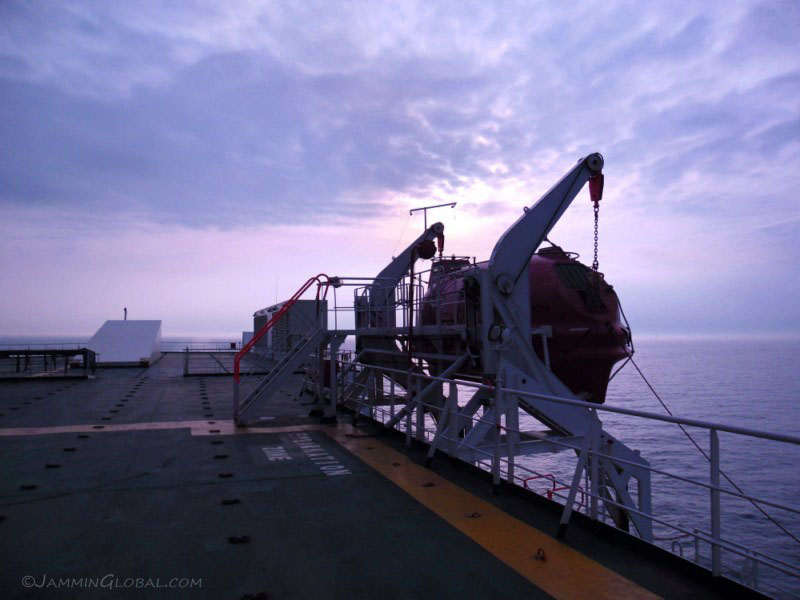
The skies changed as we cruised around Europe and it was much more overcast and gloomy. I couldn't spend as much time outside compared to the beginning of the trip.
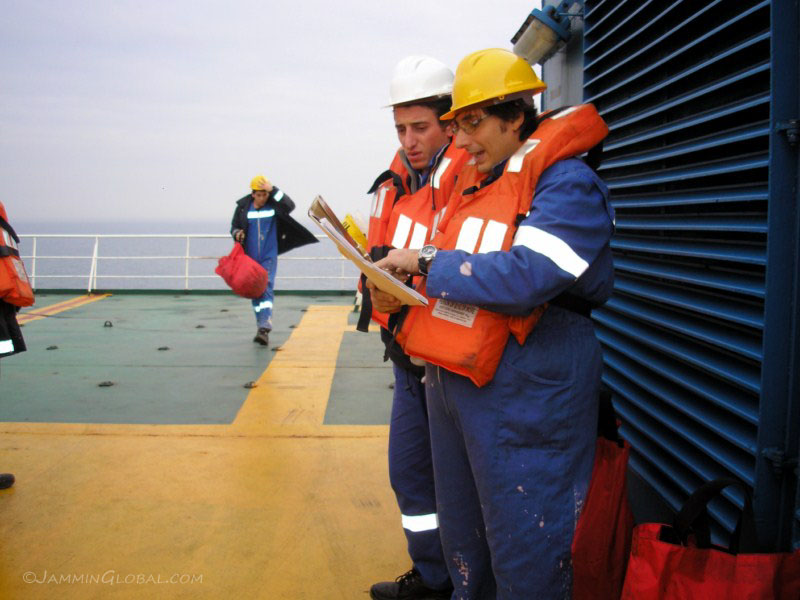
One last safety drill before docking in Germany.
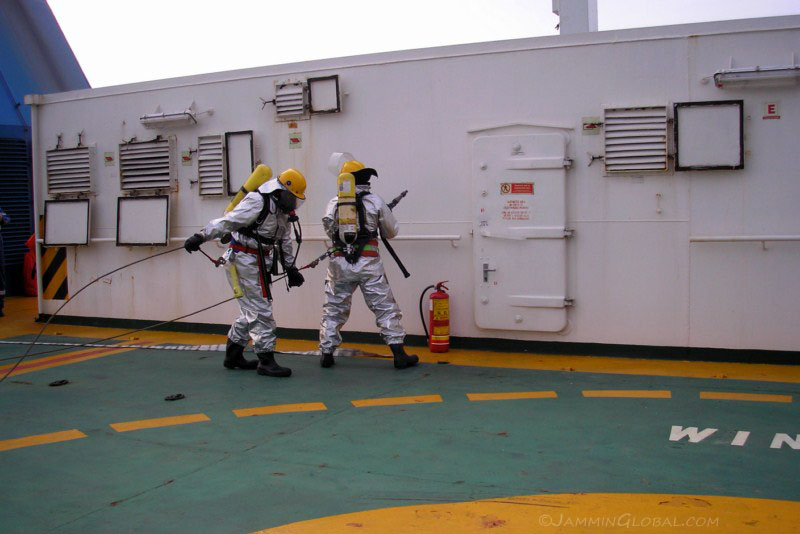
This time the crew simulated a fire in this control room on the top deck.
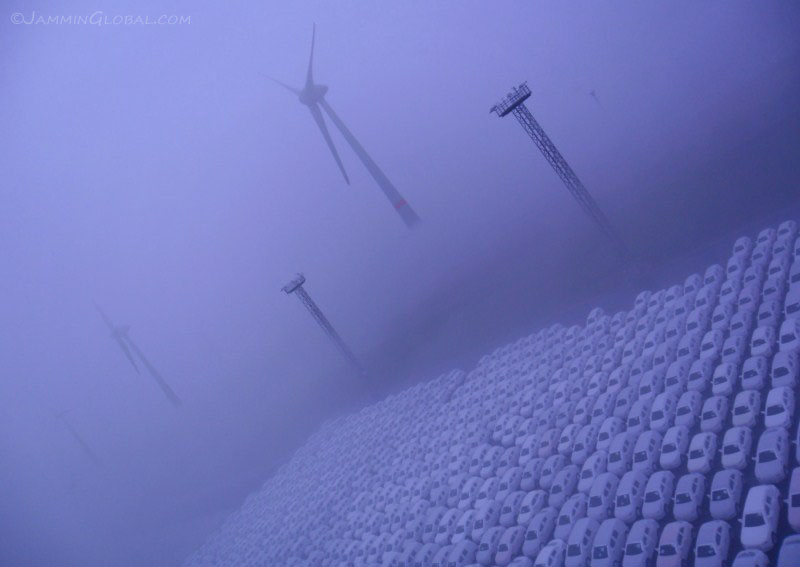
A day before landing in Hamburg, we woke up to this eerie sight of wind turbines sticking up through a thick layer of fog and rows of white cars. This is Emden, the westernmost city on the German coast with Holland just across the border.
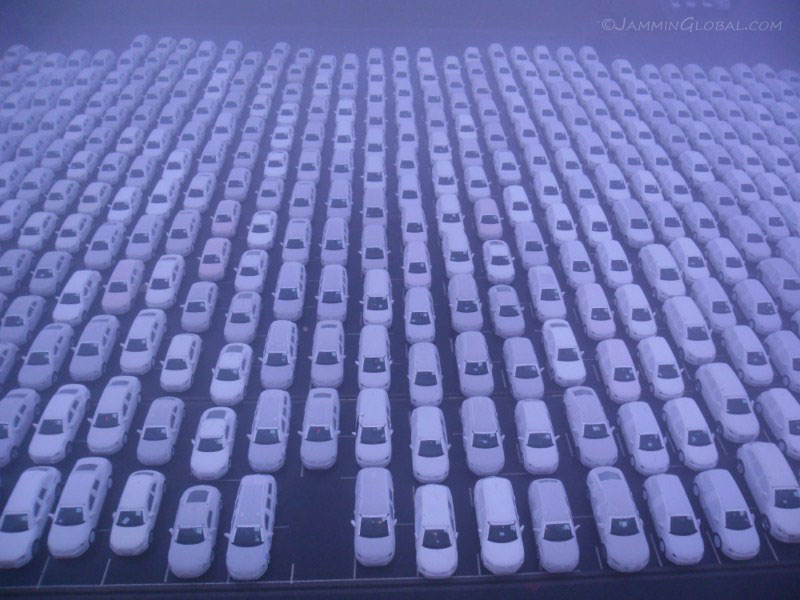
Rows upon rows of white-clad cars ready to be shipped.
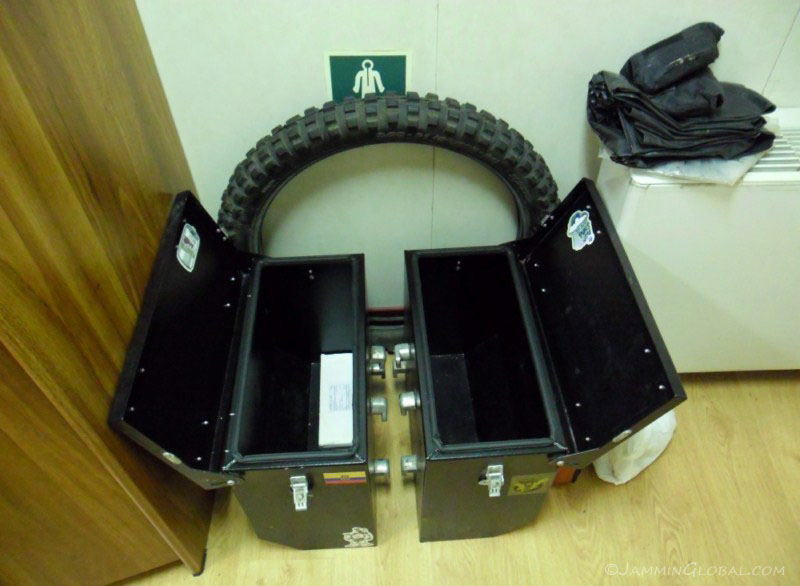
Nice, clean panniers, after hauling dust and grime from all over South America. Tomorrow we would be getting down and I repacked all of my belongings.
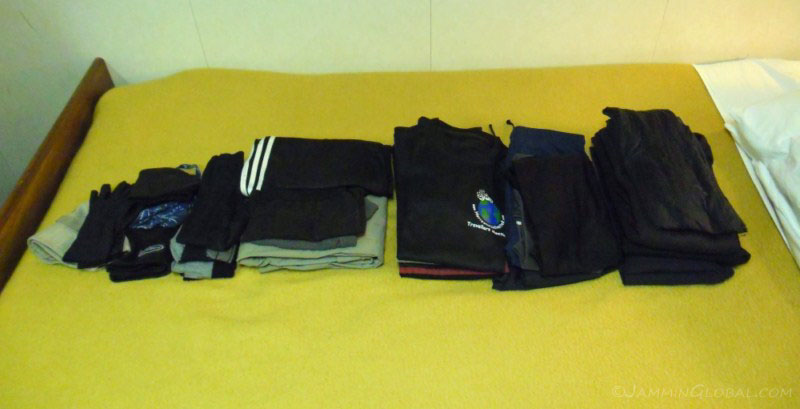
These are all my clothes, that consists of one pair of pants (that zip-off into shorts), sleeping shorts, 2 boxers, 5 t-shirts, 3 sets of base layers (for wearing under the outer riding gear) and two sets of increasing thickness thermals, along with 3 pairs of increasing thickness socks (natural silk, regular and smart wool). It's been good to see that this amount of clothing has been comfortable enough to live with for this past year. However, if I stay in one place for more than a week, I'm left wanting for more tops to not feel socially awkward. So, the trick is to keep moving and no one notices.
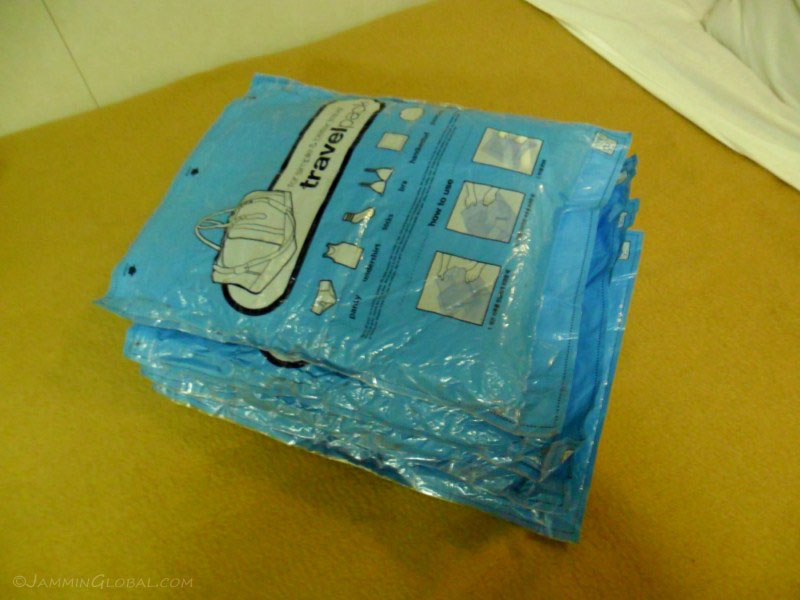
All the clothes are packed in vacuum travel bags that squeeze out the air and compress the volume taken up. These bags are fragile, so I reinforced them with a roll of clear, plastic tape and they've been effective since São Luís in Brazil, which was about 6 months ago. I buy them from this eBay retailer in South Korea who ships a set of 4 of them for $10 (price went up to $12 now) with worldwide shipping included (except Africa). With the air squeezed out, it also lightens up the load, since air has weight and this all fits in my right pannier along with my toiletry/daily chargers bag, water filter and a tool bag.
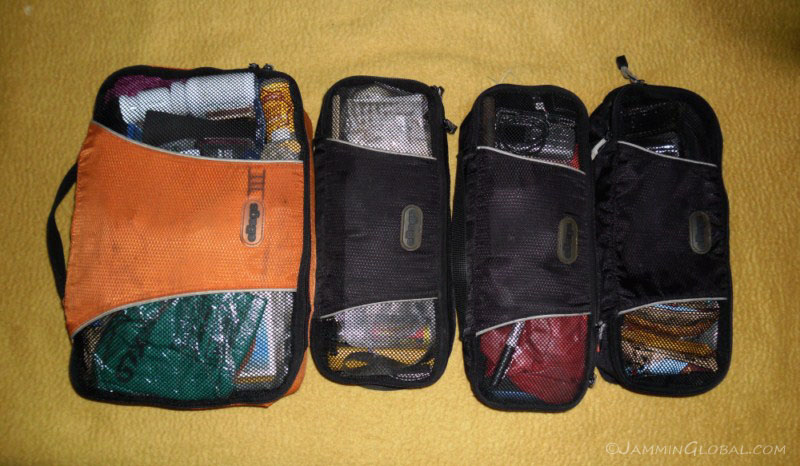
The four vacuum bags above fit into two large liner bags (like the one on the left) and then I have these four packing cubes for miscellaneous tools and spares, including my medical kit, an emergency meal, multimeter, zip-ties, spark plugs, spare fuel hose, etc. These bags are great since they allow for different configurations inside the panniers and their elongated shape allows me to pull out just what I need, staying organized while on the road. I bought them from eBags.
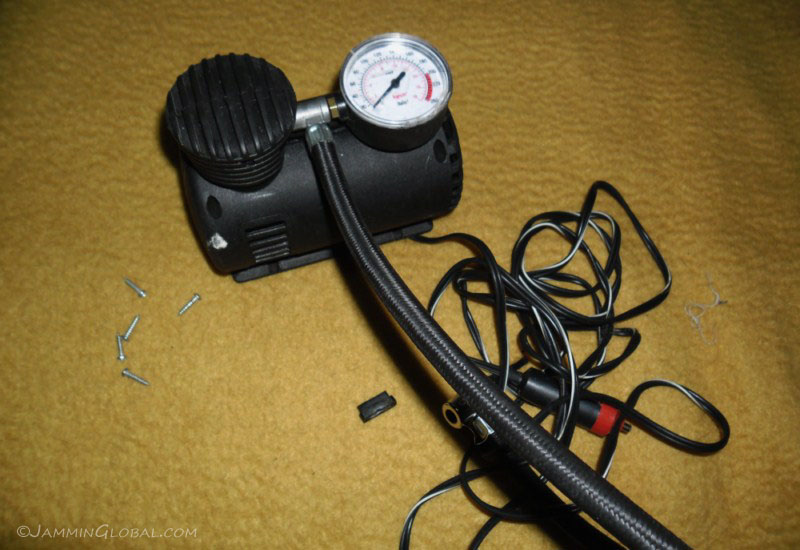
My original air compressor rusted due to a water leak and I picked up this spare in Argentina, but didn't have the time till now to strip it down to bike-travel mode. Remove the screws and...
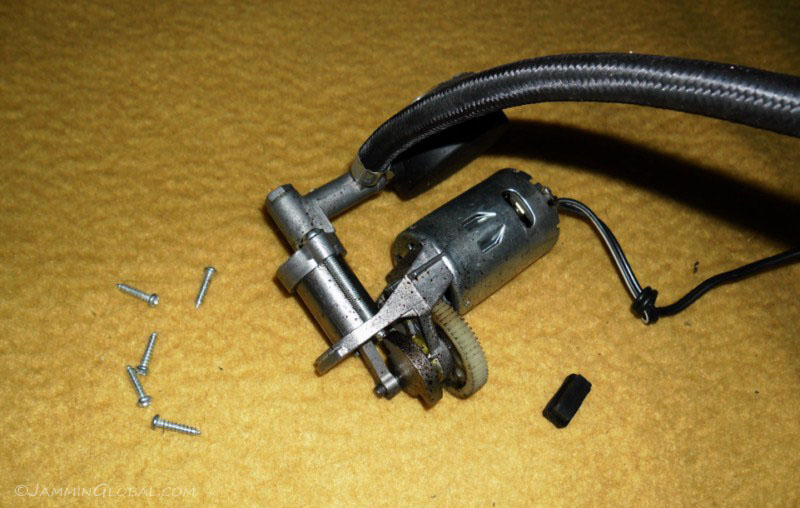
...with the plastic housing discarded, this is all you need, the actual compressor, which is very small and fits in the cap of one of my mega tool tubes. You can buy these compressors from any auto parts store and they are quite durable if you take care of them. They make adjusting the tires to the appropriate air pressures for the conditions a breeze.
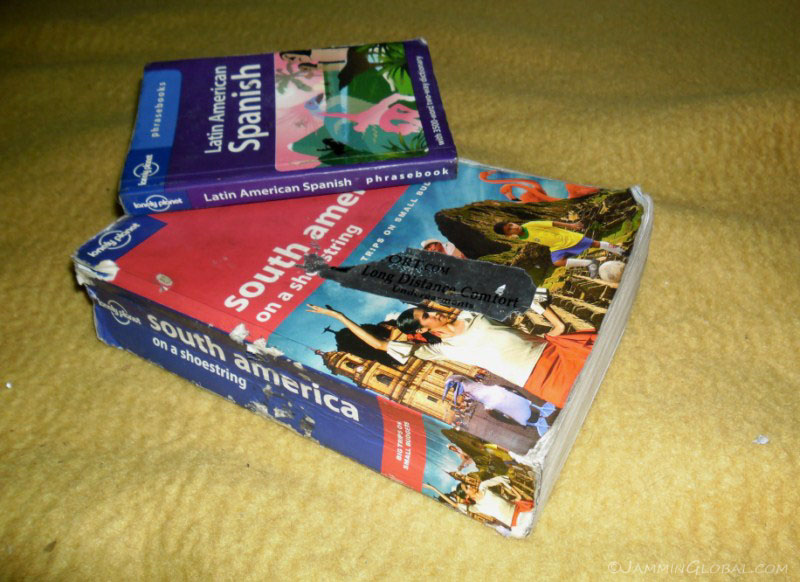
Clearing out and discarding stuff, I left behind my Lonely Planet South America on a Shoestring and Latin American Spanish phrasebook on the ship, for southbound travelers heading that way. This was a good guide and I like the books Lonely Planet puts out, especially because they have lots of detailed maps from regions down to cities and some information on road conditions between towns. However, it should be noted that this is a 'guide' and not a 'travel bible'. I take what they say in there as a suggestion and then see what it's really like on the ground. Most of the time, it's accurate. It is primarily geared for backpackers taking buses and I even wrote to them suggesting that I could help them make a motorcycle edition with more information on border crossings and motorcycle-friendly lodging and recommended mechanics, but they turned me down. Alisa (MotoAdventureGal) had a good idea about adding a small motorcycle logo next to lodging that had space to park a bike (like a courtyard). However, I think we're too small a market for them to care. The phrasebook was also highly useful. After listening to the language lessons from Michel Thomas, I would then use the phrasebook as I was walking around and this helped me to pick up the language. I also used their Brazilian Portuguese phrasebook and now have one for all of Africa with a little bit on 13 different languages.
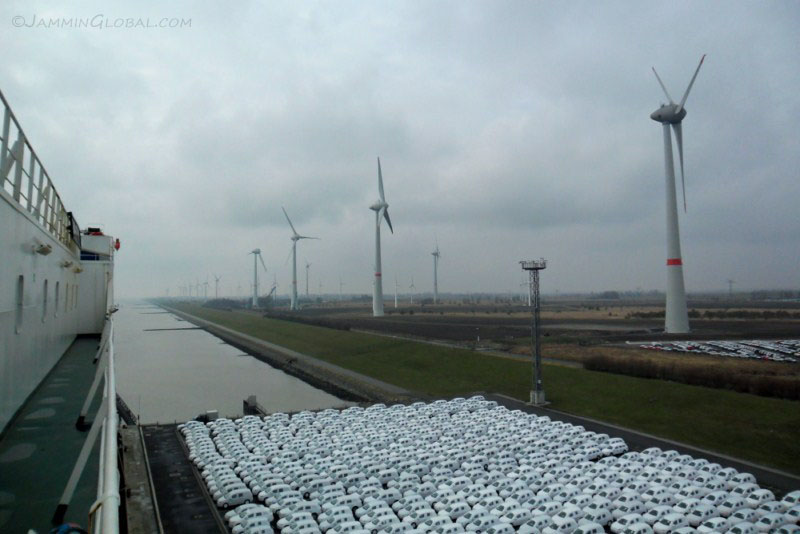
In the afternoon, the fog cleared and now wind turbines were visible into the horizon.
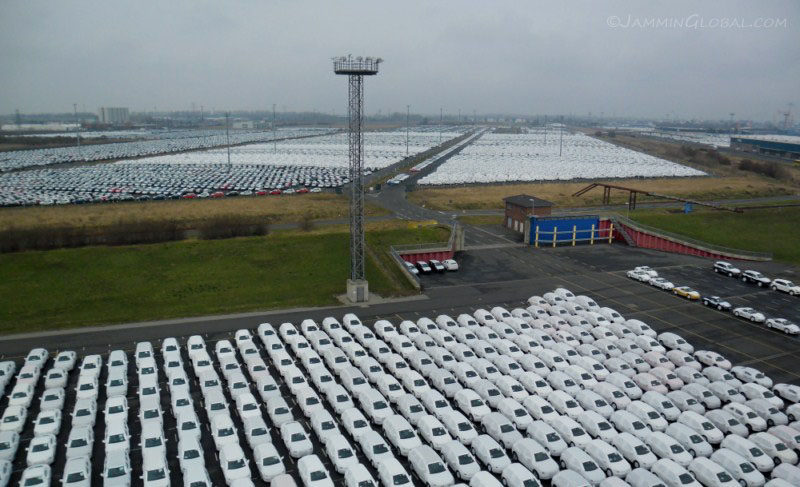
Emden is a small town and its biggest employer is this huge Volkswagen plant, which was setup here in 1964 to take advantage of being on the westernmost port of Germany for the shortest route possible for exports, making this one of the three main ports for car shipping in Europe.
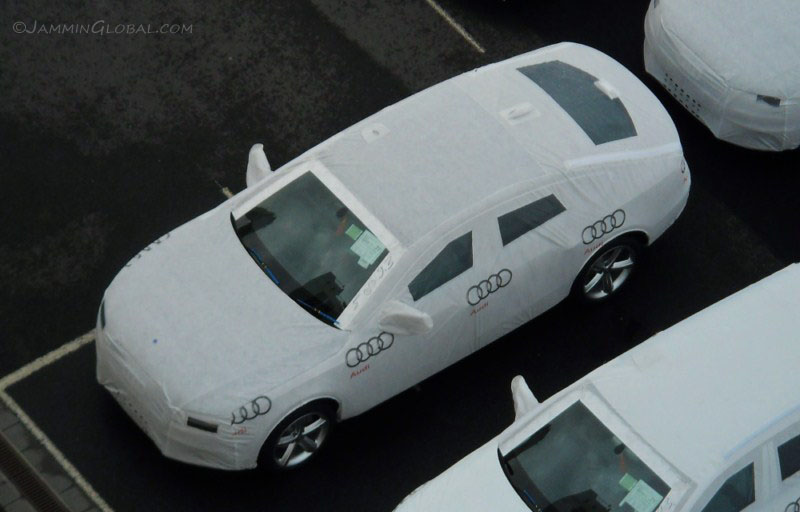
Besides the Volkswagen brand, the company owns Audi, Porsche, Bentley, Lamborghini, SEAT and Škoda. Here, newly finished Audi A4s, covered in a protective wrapping, await shipment to foreign destinations.
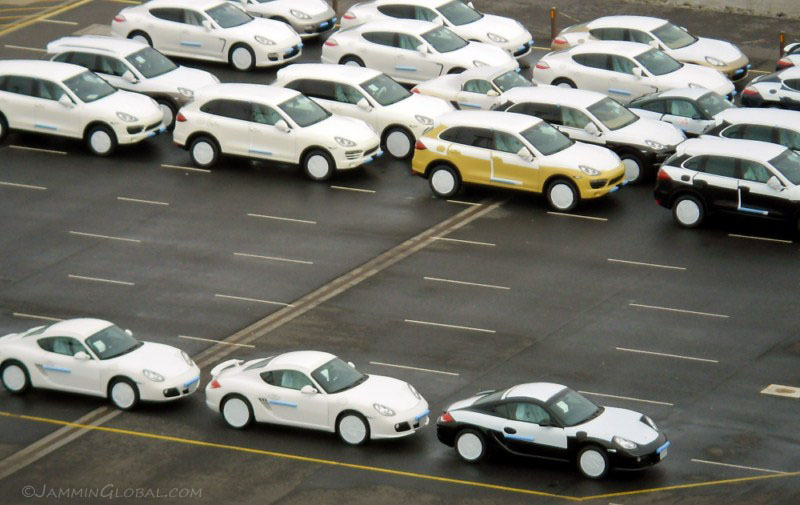
New Porsche 911s, Cayennes and the 4-door Panamera saloon, ready to keep the German export-oriented economy going strong as emerging markets increase their demand of high quality German automobiles. I've been a BMW (car) fan since a young age and had an old 325i and the new Mini Cooper, so I see where the reputation comes from. Even with a relatively small population of around 81 million, Germany is now the world's second largest exporter, behind China and they didn't feel the blow that other western economies experienced during the recent financial crisis.
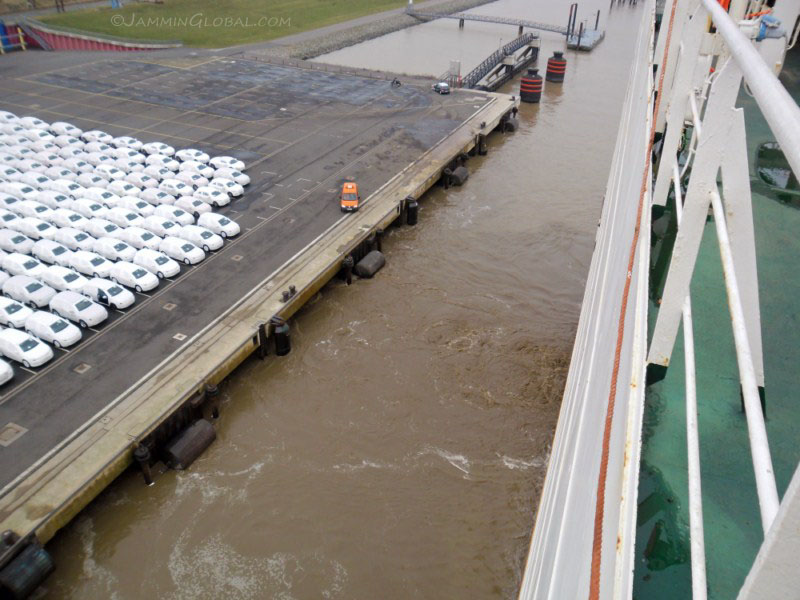
Pushing off from Emden, after a search by the Zoll (German customs in the orange van) of our rooms and our vehicles as this was our first port of call in Europe. They weren't really that nice and all the passengers said it was a rude welcome to Europe. They came into our rooms and asked, "Anything to declare? Cigarettes, alcohol, marijuana?" Then they searched our vehicles in the hold and said we would be called back down if the dogs smelled anything funny. I was worried about the spices, but all was good.
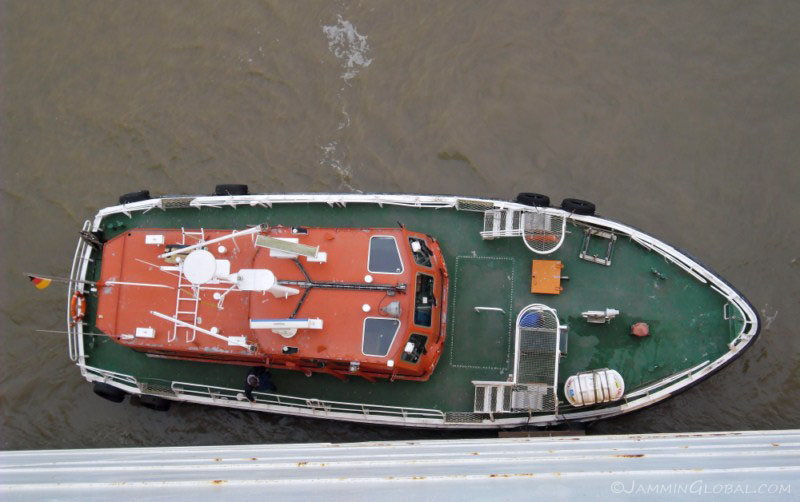
The pilot boat coming alongside...
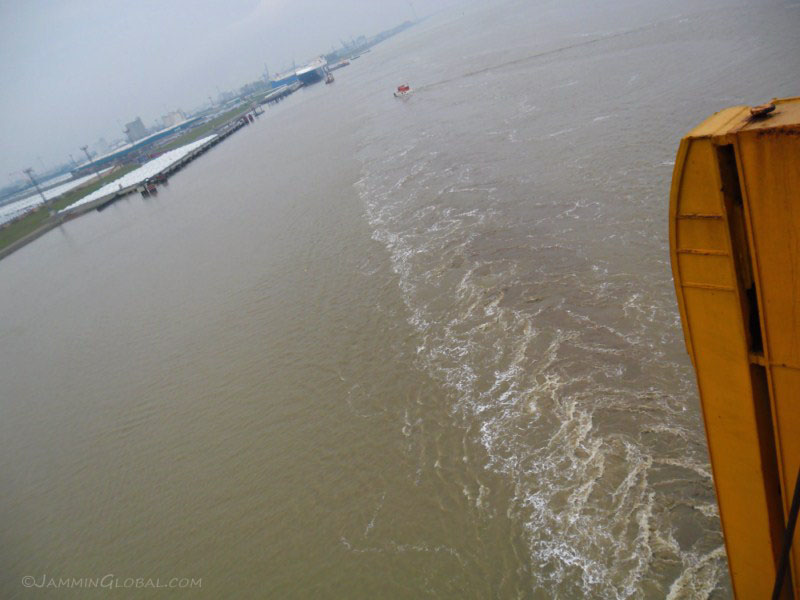
...and steaming out of Emden, around the north coast of Germany for one last night on board the Grande Francia.
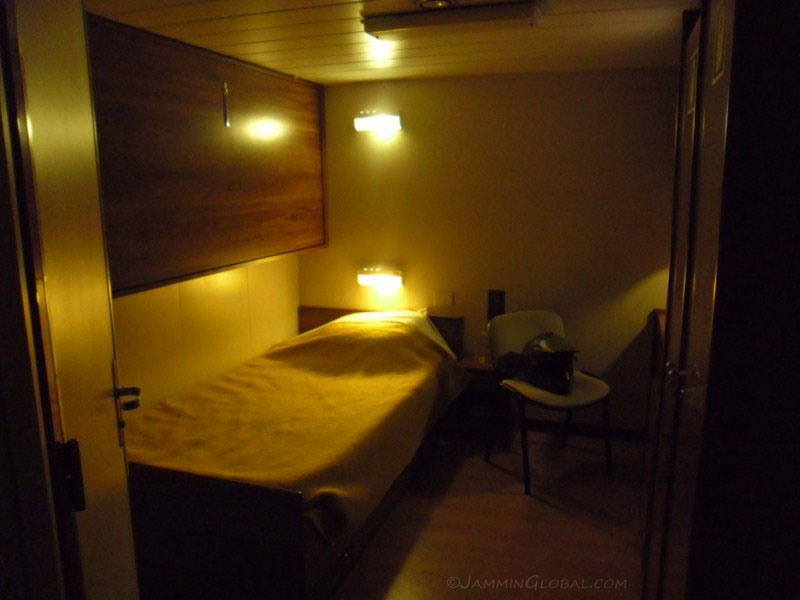
I enjoyed this journey on board a cargo ship for 26 days. I especially liked the part about sleeping in the same bed for more than a week and having my own room for these days, as privacy is a luxury when traveling like I do, staying frequently with others. I cherished the small things like being able to put things on the small table next to the bed and not having to worry about packing up all my things every morning. However, I felt refreshed now and it was back to living on the road. Europe and Africa lay ahead.

Last dinner on board and this group of passengers were good company, making the voyage enjoyable. We shared lots of stories of our travels, along with photo slideshows and videos. The French couple helped me practice my French and Jean was a friendly American to connect with. The Europeans gave me some tips about what to expect from driving in Europe and I was happy to share some Indian cooking with them.
I was excited about this ship journey before my trip even began and I wasn't let down. It's a unique experience and a thrilling way to travel slowly in this age of instant everything. The 12,000 km (7,453 mi) journey from Buenos Aires to Hamburg took 26 days and called in to 5 ports along the way, giving us a glimpse into the freigther side of our modern world. We crossed from 34 degrees south and 58 degrees west to 53 degrees north and 10 degrees east, traversing across a huge swathe of the planet. I'll be looking for further freighter travel in the future.
Next: Europe, Part 1: Authobahn into Paris
Previous: Grimaldi, Part 2: Crossing the Atlantic Ocean to Dakar